Crossing Cultural Boundaries: Saint George in the Eastern Mediterranean under the Latinokratia (13th–14th Centuries) and His Mythification in the Crown of Aragon
Abstract
:1. Saint George, a Saint for Cross-Cultural Studies
Parmi les saints de l’antiquité, nul n’a éclipsé la gloire de Saint Georges. Sa renommée s’est répandue dans toutes les parties du monde chrétien; l’Orient et l’Occident l’ont célébré avec enthousiasme.
2. Saint George in Frankish-Palaiologan Greece
(…) let’s not forget that the whole Greece is, in many respects, a frontier.
2.1. Saint George in the Byzantine Empire: Komnenian and Palaiologan Uses
2.2. Saint George in the Frankokratia: Exchanges and Cultural Identities
2.3. Saint George under Catalan Rule
ĂΝΙCΤOΡΙΘH • OΘΥOC • ΚΕ ΠAΝCΕΠΤÒC • ΝAOC Τ[OΥ AΓΙOΥ ΜΕΓAΛOΜAΡΤΥΡOC]ΓΕΩΡΓΙOΥ • ΔHÄ CΙΝΕΡΓΙAC ℧ ΠOΘOΥ ΠOΛOΥ • ΤOΥ Θ<E>ΩCΕΒΕCΤAΤOΥΚAΒAΛAΡΙ ΜHCΕΡ AΝΤOΝH • ΤΕ ΦΛAΜA ~~~~~~OΔÈ ΤΕΛÓC•HΛΙΦÉΝ ΠOΛΩΝ ΜAΡΤΙΡ<Í>ΩΝ•OΔΕ ΤÉΛOC ΕÝΡΕΝἨCΤOΡHA AΥΤΕΙ ΠAΡA ΓΕΡΜAΝOΥ • ΙΕΡΩΜOΝAΧOΥ • ΚÈ ΚA[ΘH]ΓOΥΜÉΝOΥ • ΚΕ ΝΙΚOΔΕΙΜOΥ ΙΕΡΩΜOΝÁΧOΥ • ΤÒΝ AΥΤAΔÈλΦOΝ • ΤOΥC AΝAΚÈΝHCAΝΤA<C> ΤΩΝ HΚOΝ ΤOΥΤOΝ+ ΕΤOΥC, ČΤΏΙ͠Θ (ỈᵔΝΔΙΚΤΙΩΝOC) Θ +
Ἀνιστορήθη ὁ θεῖος καὶ πάνσεπτος ναός τοῦ ἁγίου μεγαλομάρτυροςΓεωργίου διὰ συνεργίας καὶ πόθου πολλοῦ τοῦ θεοσεβεστάτουκαβαλάρη μισὲρ Aντώνη τε Φλάμα ~~~~~~ὅδε/ὧδε τέλος εἴληφεν πολλῶν μαρτυρίων. ὅδε/ὧδε τέλος εὗρενἱστορία αὕτη παρὰ Γερμανοῦ ἱερομονάχου καὶ καθη-γουμένου καὶ Νικοδήμου ἱερομονάχου τῶν αὐταδέλ-φων τοὺς νακαινίσαντας τὸν οἶκον τοῦτονἔτους, ČΤΏΙ͠Θ ἰνδικτιῶνος Θ΄
(This godly and sacred church of the holy great martyr George was (re)painted with the assistance and great desire of the most God-respecting knight sir Antoni te Flama. Such was the end of many toils. So came to an end this painting, work by Germanus the priest-monk and monastery head and Nicodemus priest-monk, these two being brothers who renovated his church + year 6819 indiction 9th+).(source of transcription and translation: Kostarelli 2019, pp. 20–21)
HCΤOΡΙΘH H ΠAΡOΥCA ΚAΜAΡA ΔHA ΕΞOΔOΥ ΘΕOΔΩΡOΥIEPEOC TOY ΠOΤ(Ε) ΠAΠA ΤOΥ CAΚΤOΥΡAΡΙ KE MNHCTHTI K(YPI)E THN ΨΥΧHΝ THC ΔOΥΛH(C) COYHPHNHC TH(C) CHNBIOY AYTOY EN THHMEPA THC KPICEΩC AMHN (ETOYC) ϚΩΛH: ηστορίθη δε δηά χηρ(ός) κ[αμού γεω]ργίου του αρά αμήν:Aφεντέβοντος δε ντον αλφ---οςηός ρέ φεδερήγουTHIS ARCH (chamber or vaulted space?) WAS PAINTED AT THE EXPENSE OF THEODOROS/THE PRIEST {SON?} OF THE FORMER PRIEST THE ACTUARIUS AND REME/MBER LORD THE SOUL OF YOUR SERVANT/EIRENE HIS WIFE IN THE/JUDGEMENT DAY AMEN (YEAR) 6/838: painted by the hand of myself George of Aras amen:/during the reign of don Alfonso/son of king Federick22
2.4. Epilogue. The Mythification of Saint George in the Kingdom of Aragon
Deus, qui beato Georgio, martiri tuo, suis meritis victoriam in bellis tribuisti, concede propicius ut quam eius bene sciencia postimus victoriam de inimicis nostris eius auxilio consequamur, per Dominum. (Letter of King Peter the Ceremonious to the bishops of the Kingdom, on 5 November 1356, Arxiu de la Corona d’Aragó (ACA), Can. Reg. 1.380, ff. 70v-71r).
Funding
Acknowledgments
Conflicts of Interest
References
Primary Sources
Avril, François, and Marie-Thérèse Gousset. 1984. Manuscrits Enluminés D’origine Italianne. 2. XIIIè Siècle. Paris: Bibliothèque National de France.Morel-Fatio, Alfred, ed. 1885. Libro de los Fechos et Conquistas del Principado de Morea Compilado por Comandamiento de don Fray Johan Ferrández de Heredia. Geneva: Imprimerie Jules-Guillaume Fick/Société de l’Orient Latin.Bibliography
- Albera, Dionigi, and Benoît Fliche. 2012. Muslim Devotion Practices in Christian Schrines: The Case of Istanbul. In Sharing Sacred Spaces in the Mediterranean. Christians, Muslims and Jews at Shrines and Sanctuaries. Edited by Maria Couroucli and Dionigi Albera. Bloomington: Indiana University Press, pp. 94–117. [Google Scholar]
- Anglès, Higini. 1961. L’ordre de Sant Jordi durant els segles XIII-XV i la devoció dels reis d’Aragó al Sant Cavaller. In Miscel·lania dedicada a E. Fonserè i Riba. Barcelona: Gustavo Gili, pp. 41–65. [Google Scholar]
- Anguera, Pere. 2004. Sant Jordi, patró de Catalunya. Estudis d’Història Agrària 17: 67–76. [Google Scholar]
- Anuari. 1921–1926. El Segell de la Companyia Catalana d’Orient. Anuari de l’Institut d’Estudis Catalans VII: 302–4. [Google Scholar]
- Athanasoulis, Demetrios. 2013. The Triangle of Power. Building Projects in the Metropolitan Area of the Crusader Principality of the Morea. In Viewing the Morea. Land and Peole in the Late Medieval Peloponnese. Edited by Sharon E. J. Gerstel. Washington, DC: Dumbarton Oaks, pp. 111–51. [Google Scholar]
- Ayensa i Prat, Eusebi. 2013. Els Catalans a Grècia. Castells i Torres a la Terra dels Déus. Barcelona: Editorial Base. [Google Scholar]
- Babuin, Al. 2011. Annexe: Les Illustrations du Petropolitanus Graecus 115. In Greeks, Latins and Intellectual History 1204–1500. Edited by Martin Hinterberger and Chris Schabel. Leuven, Paris and Walpole: Peeters, pp. 235–42. [Google Scholar]
- Barsanti, Claudia. 2001. Costantinopoli e l’Egeo nei primi decenni del XV secolo: La testimonianza di Cristoforo Buondelmonti. Rivista dell’Istituto Nazionale d’Archeologia e Storia dell’Arte 56: 83–254. [Google Scholar]
- Bartusis, Mark C. 1989. The Megala Allagia and the Tzaousios: Aspects of Provincial Military Organization in Late Byzantium. Revue des études byzantines 47: 183–207. [Google Scholar] [CrossRef]
- Baydal Sala, Vicent. 2010. Santa Tecla, San Jorge y Santa Bárbara: Los monarcas de la Corona de Aragón a la búsqueda de reliquias en Oriente (siglos XIV–XV). Anaquel de Estudios Árabes 21: 153–62. [Google Scholar]
- Bogevska, Saska. 2012. The Holy Trinity in the diocese of the archbishopric of Ohrid in the second half of the 13th century. Patrimonium 10: 139–73. [Google Scholar]
- Bon, Antoni. 1969. La Morée Franque. Recherches Historiques, Topographiques et Archéologiques sur le Principauté d’Achaïe (1205–1430). Texte. Paris: Éd. De Boccard. [Google Scholar]
- Bowman, Glenn. 2012. Identification and Identify Formations around Shared Shrines in West Bank Palestine. In Sharing Sacred Spaces in the Mediterranean. Christians, Muslims and Jews at Shrines and Sanctuaries. Edited by Maria Couroucli and Dionigi Albera. Bloomington: Indiana University Press, pp. 10–28. [Google Scholar]
- Brooks, Ernst Walter, ed. 2006. Acts of Saint George (Analecta Gorgiana 8). Piscataway: Gorgias Press LLC. [Google Scholar]
- Budge, Ernst Alfred Wallis. 1930. George of Lydda, the Patron Saint of England: A Study of the Culture of St. George in Ethiopia. London: Luzac’s Semitic Text and Translation Series, p. 20. [Google Scholar]
- Buondelmonti, Chistophoro. 1824. Liber Insularum Archipelagi. Edited by G. R. Ludwig von Sinner. Lepizig and Berlin: G. Reimer. [Google Scholar]
- Cacho Blecua, Juan Manuel. 1997. El Gran Maestre Juan Fernández de Heredia. Zaragoza: Caja de Ahorros de la Inmaculada de Aragón. [Google Scholar]
- Carreras Candi, Francesch. 1916. Introducció de la festa de Sant Jordi en la Corona d’Aragó. Butlletí Centre Excursionista de Catalunya XXVII 256: 113–22. [Google Scholar]
- Castiñeiras, Manuel. 2016. Paliachora (Egina), el Sinaí y Cataluña a finales del siglo XIV: Hibridación artística, política y peregrinación en el Mediterráneo oriental. In Imagens e Liturgia na Idade Media. Edited by Carla Varela Fernandes. Lisboa: Bens Culturais da Igreja, vol. 5, pp. 9–56. [Google Scholar]
- Castiñeiras, Manuel. 2018a. Weaving Stories, Images and Devotions: The Medieval Mediterranean as a Stage. In Ein Meer und seine Heiligen. Hagiographie in mittelalterliche Mediterraneum. Edited by Nikolas Jaspert, Christian A. Neumann and Marco di Branco. Paderborn: Ferdinand Schöningh, pp. 69–107. [Google Scholar]
- Castiñeiras, Manuel. 2018b. Shifting Identities and Traveling Objects: Artistic Encounters with Byzantium during the Expansion of the Crown of Aragon. In Center 38. National Gallery of Art. Center for Advanced Study in the Visual Art. Record of Activities and Research Reports, June 2017–May 2018. Washington, DC: National Gallery of Art, pp. 85–87. New York: Harry N. Abrams, pp. XXIII–XXXVIII. [Google Scholar]
- Castiñeiras, Manuel. 2018c. Patrons, institutions and public in the making of Catalan Romanesque art during the Comital period (1000–1137). In Romanesque Patrons and Processes. Design and Instrumentality in the Art and Architecture of Romanesque Europe. Edited by Jordi Camps, Manuel Castiñeiras, John McNeill and Richard Plant. New York: British Archeological Association/Routledge, pp. 143–58. [Google Scholar]
- Castiñeiras, Manuel, and Abenza Verónica. 2014. Sant Martí de Puigbò: Una iconografia per a Ramon Berenguer III? In Pintar fa mil anys. Els colors i l’ofici del pintor romànic. Edited by Manuel Castiñeiras and Judit Verdaguer. Bellaterra: Servei de la Universitat Autònoma de Barcelona, pp. 71–86. [Google Scholar]
- Cavallo, Guglielmo. 2017. Leer en Bizancio. Buenos Aires: Colección Scripta Manevit. [Google Scholar]
- Chapman, Conrad. 1926. Michel Paléologue, Restaurateur de L’empire Byzantine (1261–1282). Paris: Éugene Figuière. [Google Scholar]
- Cingolani, Stefano. 2014. Sant Jordi, una llegenda mil·lenària. Barcelona: Editorial Base. [Google Scholar]
- Cingolani, Stefano M. 2015. Vida, viatges i relates de Ramon de Muntaner. Barcelona: Editorial Base. [Google Scholar]
- Cooper, J. Eric, and Michael J. Decker. 2012. Live and Society in Byzantine Cappadocia. New York: Palgrave Macmillan. [Google Scholar]
- Couroucli, Maria. 2012a. Sharing Sacred Places. A Mediterranean Tradition. In Sharing Sacred Spaces in the Mediterranean. Christians, Muslims and Jews at Shrines and Sanctuaries. Edited by Maria Couroucli and Dionigi Albera. Bloomington: Indiana University Press, pp. 1–9. [Google Scholar]
- Couroucli, Maria. 2012b. Saint George the Anatolian: Master of Frontiers. In Sharing Sacred Spaces in the Mediterranean. Christians, Muslims and Jews at Shrines and Sanctuaries. Edited by Couroucli Maria and Dionigi Albera. Bloomington: Indiana University Press, pp. 118–40. [Google Scholar]
- D’Alòs-Moner, Ramon. 1926. Sant Jordi, patró de Catalunya. Barcelona: Barcino. [Google Scholar]
- De la Figuera, Gaspar (Frey). 1738. Vida, Martirio, Reliquias, Templos, Milagros, Apariciones i Excelencias del Insigne Mártir i Esforzado Capitán de Christo San Jorge. Valencia: Imprenta de Antonio Balle. [Google Scholar]
- De LaRoncière, Charles. 1929. Les Portulans Italiens. Lyon: Amis de la Bibliothèque de Lyon. [Google Scholar]
- De Sagarra y Siscar, Fernando. 1898. Apuntes para un estudio de los sellos del rey D. Pedro IV de Aragón: Memoria leída en la Real Academia de Buenas Letras de Barcelona en sesión de 25 de Enero de 1892. Memorias de la RealAcademia de Buenas Letras de Barcelona VI: 101–74. [Google Scholar]
- Delahaye, Hippolite. 1966. Les Passions des Martyrs et les Genres Littéraires. Bruxelles: Société des Bollandistes. [Google Scholar]
- Delaville le Roulx, Joseph. 1913. Les Hospitailers à Rhodes Jusqu’à la Mort de Philibert de Naillac. Paris: Ernest Leroux Editeur. [Google Scholar]
- Delehaye, Hyppolite, ed. 1902. Synaxarium Ecclesiae Constantinopolitanae: E Codice Sirmondiano nunc Berolinensi; Adiectis Synaxariis Selectis. Bruxelles: Socios Bollandianos. [Google Scholar]
- Delehaye, Hyppolite. 1909. Les Légendes Grecques des Saintes Militaires. Paris: Picard. [Google Scholar]
- Dorsch, Klaus J. 1983. Georgszyklen des Mittelalters. Frankfurt am Main: Peter Lang. [Google Scholar]
- Duran i Duelt, Daniel. 2018. Los ducados de Atenas y Neopatria en el comercio regional e interanacional durante la dominación catalana (siglo XIV). I. El comercio regional a través del observatorio de Candía. Estudios Bizantinos 6: 111–46. [Google Scholar]
- Eaton, Natasha. 2013. Mimesis across Empires. Artworks and Networks in India. Durham and London: Duke University Press, pp. 1765–860. [Google Scholar]
- Edgington, Susan, and Carol Sweetenham, eds. 2011. The Chanson d’Antioche: An Old-French Account of the First Crusade. Farmham: Ashgate. [Google Scholar]
- Egea, José M., ed. 1996. La Crónica de Morea. Madrid: CSIC. [Google Scholar]
- Eliades, Ioannis A. 2017. The Painting Production of the 13th Century in Cyrprus between Two Worlds. In Maniera Cypria. The Cypriot Painting of the 13th Century between Two Worlds. Edited by Ioannis A. Eliades. Byzantine Museum of the Archbishop Makarios III Foundation: Lefkosia, pp. 45–63. [Google Scholar]
- Expósito Sebastián, Manuel, José Luis Pano Gracia, and Mª Isabel Sepúlveda Sauras. 1996. La Aljafería de Zaragoza. Guía histórico-artística y Literaria. Zaragoza: Cortes de Aragón. [Google Scholar]
- Fancy, Husein. 2016. The Mercenary Mediterranean. Sovereignty, Religion and Violence in the Medieval Crown of Aragon. Chicago and London: The University of Chicago Press. [Google Scholar]
- Fort i Cogul, Eufemià. 1971. Sant Jordi d’Alfama. L’Orde Militar Català. Barcelona: Rafael Dalmau. [Google Scholar]
- Geanakoplos, Deno John. 1953. Greco-Latin Relations on the Eve of the Byzantine Restauration: The Battle of Pelagonia—1259. Dumbarton Oaks Papers VII: 101–41. [Google Scholar]
- Geanakoplos, Deno John. 1959. Emperor Michael Paleologous and the West, 1958–1282. A Study in Byzantine-Latin Relations. Cambridge: Harvard University Press. [Google Scholar]
- Gelao, Clara. 1998. La Pinacoteca Provinciale di Bari. Opere dall’XI al XVIII secolo. Roma: Argos. [Google Scholar]
- Georgopoulou, Maria. 2001. Venice’s Mediterranean Colonies. Architecture and Urbanism. Cambridge: Cambridge Universitary Press. [Google Scholar]
- Georgopoulou, Maria. 2004. The Artistic World of the Crusaders and Oriental Christians in the Twelfth and Thirteenth Centuries. Gesta 43: 115–28. [Google Scholar] [CrossRef]
- Georgopoulou, Maria. 2015. The Landscape of Medieval Greece. In A Companion to Latin Greece. Edited by Nikiphoros Tzougarakis and Peter Lock. Leiden-Boston: Brill, pp. 326–68. [Google Scholar]
- Gerstel, Sharon E. J. 2001. Art and Identity in the Medieval Morea. In The Crusades from the Perspective of Byzantium and the Muslim World. Edited by Angeliki Laiou and Roy P. Mottahedeh. Washington, DC: Dumbarton Oaks Research Library and Collection, pp. 263–78. [Google Scholar]
- Gerstel, Sharon E. J. 2017. Rural Lives and Landscapes in Late Byzantium. Art, Archeology, and Ethnography. Cambridge: Cambridge University Press. [Google Scholar]
- Goodenough, Lady, ed. 2000. Ramon Muntaner. In Chronicle. Catalan Series; Cambridge: Parentheses Publications. [Google Scholar]
- Grabar, André. 1976. Sculptures Byzantines du Moyen Âge. II. XIe-XVIe siècle. Paris: CNRS. [Google Scholar]
- Grossman, Heather E. 2012. On Memory, Transmission and the Practice of Building in the Crusader Mediterranean. In Mechanisms of Exchange: Transmission in Medieval Art and Architecture of the Mediterranean, ca. 1000–1500. Edited by Heather E. Grossman and Alicia Walker. Leiden and Boston: Brill, pp. 183–219, (Special Offprint of Medieval Encounters 18: 4–5, 2012). [Google Scholar] [CrossRef]
- Grotowski, Piotr. 2010. Arms and Armour of the Warrior Saints. Tradition and Innovation in Byzantine Iconography (843–1261). Leiden and Boston: Brill. [Google Scholar]
- Hasluck, Frederick William. 1929. Christianity and Islam under the Sultans. I. Oxford: Oxford University Press. [Google Scholar]
- Hélou, Nada. 2014. Les lieux sacrés de Beyrouth au Moyen Âge. Les deux églises de Saint-Georges. In The Holy Portolano. The Sacred Geography of Navigation in the Middle Ages. Edited by Bacci Michele and Rohde Martin. Berlin, München and Boston: De Gruyter, pp. 73–93. [Google Scholar]
- Hirschbilchler, Monika. 2005a. Monuments of a Syncretic Society. Wall Painting in the Latin Lordship of Athens, Greece (1204–1311). Ph.D. thesis, University of Maryland, College Park, MD, USA. [Google Scholar]
- Hirschbilchler, Monika. 2005b. The Crusader Painting in the Frankish Gate at Nauplia, Greece. Gesta 1: 13–30. [Google Scholar] [CrossRef]
- Hopf, Carl. 1873. Chroniques Gréco-Romanes Inédites ou peu Connues. Berlin: Weidmann. [Google Scholar]
- Hulst, Cornelia S. 1909. St. George of Cappadocia in Legend and History. London: David Nutt. [Google Scholar]
- Hurtado, Víctor, Jesús Mestre, and Toni Miserachs. 1995. Atles d’Història de Catalunya. Barcelona: Edicions 62. [Google Scholar]
- Immerzeel, Mat. 2004. Holy Horsemen and Crusader Banners. Equestrian Saints in Wall Paintings in Lebanon and Syria. Eastern Christian Art I: 29–60. [Google Scholar]
- Ivison, Eric A. 1996. Latin Tomb Monuments in the Levant. In The Archaeology of Medieval Greece. Edited by Peter Lock and Guy D. R. Sanders. Oxford: Oxbow Monograph, vol. 59, pp. 91–106. [Google Scholar]
- Jacoby, David. 1966. La Compagnie Catalane et l’État catalan de Grèce. Quelques aspects de leur historie. Journal des Savants 2: 78–103. [Google Scholar] [CrossRef]
- Jacoby, David. 1974. Catalans, Turcs et Vénitiens en Romanie (1305–1332): Un nouveau témoignage de Marino Sanudo Torsello. In Studi Medievali. III serie; Barcelona: Institut d’Estudis Catalans, vol. XV, pp. 217–61. [Google Scholar]
- Jacoby, David. 2003. L’état catalan en Grèce: Société et institutions politiques. In Els Catalans a la Mediterrània Oriental a l’Edat Mitjana. Jornades Científiques de L’insitut d’Estudis Catalans, Secció Històrico-Arqueològica, Barcelona, 11–17 Novembre 2000. Sèrie Jornades Científiques; Edited by Maria Teresa Ferrer i Mallol. Barcelona: Institut d’Estudis Catalans, vol. 11, pp. 79–101. [Google Scholar]
- Jaeger, C. Stephen. 2012. Enchantment. on Charisma and the Sublime in the Arts of the West. Philadelphia: University of Pennsylvannia Press. [Google Scholar]
- Janin, Raymond. 1969. La Géographie Ecclésiastique de L’empire Byzantin. I. Le Siège de Constantinople et le Patriarcat Œcumeénique. 3. Les Églises et les Monasteères. Paris: Institut Français d’Études Byzantines. [Google Scholar]
- Jolibert-Lévy, Catherine. 2002. La Cappadoce. Mémoire de Byzance. Paris: Éditions Paris-Mediterranée-CNRS Éditions. [Google Scholar]
- Kalavrezou-Maxeiner, Ioli. 1985. Byzantine Icons in Steatite. Wien: Verlag der Osterreichischen Akademie der Wissenschaften. [Google Scholar]
- Kalopissi-Verti, Sophia. 1992. Dedicatory Inscriptions and Donor Portraits in Thirteenth-Century Churches. Vienna: Verlag der Österreichischen Akademie der Wissenshaften. [Google Scholar]
- Kalopissi-Verti, Sophia. 2007. Relations between East and West in the Lordship of Athens and Thebes after 1204: Archeological and Artistic Evidence. In Archeology and the Crusaders: Proceedings of the Round Table, Nicosia, 1 February 2005. Edited by Peter W. Edbury, Sophia Kalopissi-Verti and Hidryma Pieride. Athens: Pierides Foundation, pp. 1–33. [Google Scholar]
- Kalopissi-Verti, Sophia. 2012. Collective Patterns of Patronage in the Late Byzantine Village: The Evidence of Church Inscription. In Donation et Donateurs Dans le Monde Byzantin: Actes du Colloque International de L’universite de Fribourg 13–15 Mars 2008. Edited by Jean-Michel Spieser and Élisabeth Yota. Paris: Desclée de Bouwer/Realités Byzantines, vol. 14, pp. 125–40. [Google Scholar]
- Kalopissi-Verti, Sophia. 2014. Monumental Art in the Lordship of Athens and Thebes under Frankish and Catalan Rule (1212–1388): Latin and Greek Patronage. In A Companion to Latin Greece. Edited by Nikiphoros Tzougarakis and Peter Lock. Leiden and Boston: Brill, pp. 369–417. [Google Scholar]
- Karachaliou, Ermioni. 2012. The Architectural and Iconographic Identity of Paliochora on Aegina. An Introduction to Its Late and Post Byzantine Churches. Ph.D. thesis, University of Manchester, Manchester, UK. [Google Scholar]
- Kasdagli, Anna-Maria. 2016. Stone Carvings of the Hospitaller Period in Rhodes. Displaced Pieces and Fragments. Oxford: Archaeopress Archeology. [Google Scholar]
- Kasdagli, Anna-Maria. 2017. Heraldry in Medieval Rhodes: Hospitallers and Others. In The Military Orders Volume III. History and Heritage. Edited by Victor Mallia-Milanes. London: Routledge. [Google Scholar]
- Kauffmann, Claus Michael. 1970. The altar-piece of St. George from Valencia. Victoria and Albert Museum Yearbook 2: 65–100. [Google Scholar]
- Kedar, Bejanmin Z. 1999. The Changing Land between the Jordan and the Sea. Aerial Photographs from 1917 to the Present. Tel Aviv: Yad Izhak Ben-Zvi Press. [Google Scholar]
- Kitapçi Bayri, Buket. 2019. Martyrs, and Dervishes. Moving Frontiers, Shifting Identities in the Land of Rome (13th-15th Centuries). Turnhout: Brill. [Google Scholar]
- Kitsiki-Panagopoulos, Beata. 1979. Cistercian and Mendicant Monasteries in Medieval Greece. Chicago: University of Chicago Press. [Google Scholar]
- Kostarelli, Alexandra. 2019. The Dedicatory Inscription of Saint George Church at Akraifnion, Boeotia (1311). Museikon. A Journal of Religious Art and Culture/Revue d’art et de culture religieuse 3: 9–24. [Google Scholar]
- Kostarelli, Alexandra. 2020. H επιγραφή του ναού του Aγίου Γεωργίου Aκραιφνίου Βοιωτίας (1311). Παρατηρήσεις µετά την ολοκλήρωση των εργασιών Aποκατάστασης. In Aρχαιολογικό έργο Θεσσαλίας και Στερεάς Ελλάδας 5.1. Θεσσαλία. Proceedings of the 5th Archaeological Meeting of Thessaly and Central Greece, 2012–2014. Edited by Alexandros Mazarakis Ainian. Volos: Ministry of Culture & University of Thessaly, pp. 1077–88. [Google Scholar]
- Krumbacher, Karl. 1911. Der Heilige Georg in der Griechischen Überlieferung. München: Verlag der Königlich Bayerischen Akademie der Wissenschaften. [Google Scholar]
- Lafuente Gómez, Mario. 2008. Devoción y patronazgo en torno al combate en la Corona de Aragón: Las conmemoraciones de San Jorge de 1356. In Aragón en la Edad Media. vol. XX, pp. 427–40. [Google Scholar]
- Lemerle, Paul. 1957. L’Émirat d’Aydin, Byzance et l’Occident. Paris: Presse Universitaires de France. [Google Scholar]
- Llompart, Gabriel. 1977. La Pintura Medieval Mallorquina. Su Entorno Cultural y su Iconografía. 3 vols. Palma de Mallorca: Luis Ripoll Editor, pp. 1977–80. [Google Scholar]
- Llompart, Gabriel. 2002. La Festa de l’Estendard entre la liturgia y el espectáculo (Mallorca siglo XIII-XXI). In La Festa a Elx. Actes del VII Seminari de Teatre i Música Medievals. Edited by J. L. Sirera. Elx: Ajuntament d’Elx, pp. 205–14. [Google Scholar]
- Lock, Peter. 1995. The Franks in the Aegean, 1204–1500. London and New York: Longman. [Google Scholar]
- Lómax, Derek W. 1965. La Orden de Santiago (1170–1277). Madrid: CSIC. [Google Scholar]
- López Sabatino, Roberto. 1933. Genoa Marinara nel Ducento. Benedetto Zaccaria, Ammiraglio e Mercante. Messina and Milan: G. Principato. [Google Scholar]
- Luccheti, Loreta. 2014. Notitia Dignitatum. L’amministrazione dell’Impero Romano. Saggi e Commenti. Rome: Istituto dell’Enciclopedia Italiana. [Google Scholar]
- Luttrell, Anthony. 1960. Greek Histories Translated and Compiled for Juan Fernández de Heredia, Master of Rhodes, 1377–1396. Speculum 35: 401–7. [Google Scholar] [CrossRef]
- Luttrell, Anthony. 1969. La Corona de Aragón y la Greica catalana, 1379–1394. Anuario de Estudios Medievales 6: 219–52. [Google Scholar]
- Lymberopoulou, Angeliki. 2006. The Church of the Archangel Michael at Kavalariana. In Art and Society on Fourteenth-Century Venetian-Dominated Crete. London: The Pindar Press. [Google Scholar]
- MacGregor, James. 2002. Salue Martir Spes Anglorum: English Devotion to Saint George in the Middle Ages. Ph.D. thesis, University of Cincinnati, Cincinnati, OH, USA. [Google Scholar]
- Macías, José Manuel, ed. 1987. Santiago de la Vorágine. In La Leyenda Dorada. Madrid: Alianza Forma, vol. I. [Google Scholar]
- Macrides, Ruth. 1980. The New Constantine and the New Constantinople – 1261? Byzantium and Modern Greek Studies 6: 13–41. [Google Scholar] [CrossRef]
- Macrides, Ruth J., Joseph A. Munitiz, and Dimiter Angelov. 2013. Pseudo-Kodinos and the Constantinopolitan Court: Offices and Ceremonies. Farnham: Ashgate. [Google Scholar]
- Magdalino, Paul. 2007. Pseudo-Kodinos’ Constantinople. In Studies on the History and Topography of Byzantine Constantinople. Edited by P. Magdalino. Aldershot: Ashgate/Variorum. [Google Scholar]
- Magnaghi, Alberto. 1898. La Carta Nautica Costruita nel 1325 da Angelino Dalorto. Florence: M. Ricci. [Google Scholar]
- Mango, Cyril. 1963. Antique Statuary and the Byzantine Beholder. Dumbarton Oaks Papers 17: 53–75. [Google Scholar] [CrossRef]
- Marco, Francisco, and Canellas Ángel. 1987. San Jorge de Capadocia. Zaragoza: Ediciones Oroel. [Google Scholar]
- Marcos Hierro, Ernest. 2005. Almogàvers. La història. Barcelona: L’Esfera dels Llibres. [Google Scholar]
- Marksimovi, Jovanka. 1967. La sculpture byzantine du XIIIè siècle. In L’Art Byzantine du XIIIe siècle. Symposium de Sopocáni 1965. Edited by Vojislav J. Djurić. Beograd: Faculté de philosophie, Département de l’histoire de l’art, pp. 33–34. [Google Scholar]
- Mark-Weiner, Temily. 2003. Narrative Cycles of the Life of St. George in Byzantine Art. Ann Arbor: University Microfilms International, New York: New York University. First Published in 1977. [Google Scholar]
- Martín Lloris, Catalina. 2005. Las Reliquias de la Capilla Real de la Corona de Aragón y el Santo Cáliz de la Catedral de Valencia (1396–1458). Ph.D. Thesis, Universitat de València, Valencia, Spain. [Google Scholar]
- Melvani, Nicholas. 2013. Late Byzantine Sculpture. Turnhout: Brepols. [Google Scholar]
- Métivier, Sophie. 2012. Byzantium in question in 13th-century Seljuk Anatolia. In Liquid & Multiple: Individuals & Identities in the Thirteenth-Century Aegean. Edited by Guillaume Saint-Guillain and Dionysios Stathakopoulos. Paris: ACHCByz, pp. 235–58. [Google Scholar]
- Meuwese, Martine. 2006. Antioch and the Crusaders in Western Art. In East and West in the Medieval Eastern Mediterranean. I. Antioch from the Byzantine Reconquest until the End of the Crusader Principality. Acta of the Congress Held at Hernen Castle in May 2003. Edited by Krijna Nelly Ciggaar, David Michael Metcalf and Victoria D. van Aalst. Leuven and Dudley: Uitgeverij Peeters en Departement Oosterse Studies, pp. 336–55. [Google Scholar]
- Migneco Malaguarnera, Francesca. 1995. Gli inediti dipinti murali del Castello di Paternò. In Federico e la Sicilia, Della Terra Alla Corona. II. Arti Figurative e Suntuarie. Edited by Di Stefano Carmela, Cadei Antonio and Andaloro Maria. Siracusa: Arnaldo Lombardo Editore, pp. 501–6. [Google Scholar]
- Miller, William. 1908. The Latins in the Levant. A History of the Frankish Greece (1204–1566). New York: E. P. Dutton and Company. [Google Scholar]
- Miller, William. 1909. The Frankish Inscription at Karditza. The Journal of the Hellenic Studies 29: 198–201. [Google Scholar] [CrossRef] [Green Version]
- Miller, William. 1921. The Zaccaria of Phocaea and Chios (1275–1329). In Essays on the Latin Orient. Cambridge: Cambridge University Press, pp. 283–98. [Google Scholar]
- Miquel Juan, Matilde. 2011. El gótico internacional en la ciudad de Valencia. El retablo de san Jorge del Centenar de la Ploma. Goya 336: 191–213. [Google Scholar]
- Molina Figueras, Joan. 2014. Sotto il segno d’Oriente. La monarquía catalano-aragonese e la ricerca del sacro nelle terre del Levante mediterraneo. In Representations of Power at the Mediterranean Borders of Europe (12th–14th Centuries). Edited by Ingrid Baumgärtner, Mirko Vagnoni and Megan Welton. Florence: SIMSEL–Edizioni del Galluzzo, pp. 71–90. [Google Scholar]
- Morfakidis, Moschos. 1981. Los catalanes en Grecia, en la obra de Nicéforos Gregoras. Cuadernos de estudios medievales y ciencias y técnicas historiográficas 6–7: 155–77. [Google Scholar]
- Morfakidis, Moschos. 1986. La presencia catalana en Grecia: Relaciones entre griegos y catalanes según las fuentes. In Relaciones inéditas entre España y Grecia. Athens: Instituto Cultural Español "Reina Sofía", pp. 93–113. [Google Scholar]
- Mullins, Jane. 2017. Tracing the Archetypes of the Legend of St. Georges through the Epochs. Ph.D. thesis, Casperen School of Graduate Studies, Drew University, Madison, NJ, USA. [Google Scholar]
- Muntada i Torrellas. 2015. La devoció a sant Jordi i la Diputació del General. In El Palau de la Generalitat de Catalunya. ART I ARQUITECTURA, I. Edited by Carbonell i Buades Marià. Barcelona: Generalitat de Catalunya, Departament de la Presidència, pp. 156–63. [Google Scholar]
- Nadal i Cañellas, Joan, ed. 2002. Arnaldus de Villanova. In Tractatus Octo in Graecum Sermonem Versi (Petropolitanus Graecus 113). Barcelona: Institut d’Estudis Catalans. [Google Scholar]
- Nelson, Robert S. 1985. A Byzantine Painter in Trecento Genoa: The Last Judgement. The Art Bulletin LXVII: 548–66. [Google Scholar] [CrossRef]
- Nicolaïdès, Andréas. 2012. The Murals of the Narthex. The Paintings of the Twelfth Century. Part One. Date and Iconography. In Asinou Across Time. Studies in the Architecture and Murals of the Panagia Phorbiotissa, Cyprus. Edited by Annemarie Wey Carr and Andréas Nicolaïdès. Washington, DC: Dumbarton Oaks Research Library and Collection, pp. 93–101. [Google Scholar]
- Nicolau D’Olwer, Lluís. 1935. Les Seigneurs Catalans d’Egine. In Εις μνήμην Σπυρίδωνος ς Λάμπρου. Athens: Comisión para la Edición de las Obras Póstumas de Spirídon Lambros. [Google Scholar]
- Nicolau d’Olwer, Lluís. 1974. L’expansió de Catalunya en la Mediterrània Oriental. Barcelona: Edicions Proa. [Google Scholar]
- Niglio, Olimpia. 2007. Akko, Perla del Mediterraneo. Pisa: Università di Pisa-Edizione SEU. [Google Scholar]
- Olympios, Michalis, and Chris Schabel. 2020. The Cistercian Abbeys of Zaraka and Isova in the Principality of Achaia. Frankokratia 1: 165–79. [Google Scholar] [CrossRef]
- Orcastegui Gros, Carmen, ed. 1986. Crónica de San Juan de la Peña (Versión Aragonesa). Zaragoza: Diputación Provincial-Institución “Fernando el Católico”. [Google Scholar]
- Page, Gill. 2008. Being Byzantine. Greek Identity before the Ottomans. Cambridge: Cambridge University Press. [Google Scholar]
- Page, Gill. 2015. Literature in Frankish Greece. In A Companion to Latin Greece. Edited by Nikiphoros Tzougarakis and Peter Lock. Leiden-Boston: Brill, pp. 288–325. [Google Scholar]
- Paisidou, Melina. 2001. H ανθρωπόμορφη Aγία Τριάδα στον Άγιο Γεώργιο της Oμορφοκκλησιάς Καστοριάς. In Aφιέρωμα στη μνήμη του Σωτήρη Κίσσα. Thessaloniki: University Studio Press, pp. 380–83. [Google Scholar]
- Palumbo, Maria Laura. 2017. Art Fugitiu: Estuis D’art Medieval Desplaçat. Edited by Rosa Alcoy. Barcelona: Publicacions de la Universitat de Barcelona, pp. 87–107. [Google Scholar]
- Pancaroglu, Oya. 2004. The Itinerant Dragon-Slayer: Forging Paths of Image and Identity in Medieval Anatolia. Gesta XLIII: 151–64. [Google Scholar] [CrossRef]
- Papadopoulos, Anastasios. 2017. Signatures of Byzantine Painters in Macedonia: Deciphering the Astrapades Code. In Entre la Letra y el Pincel: El Artista Medieval. Leyenda, Identidad y Estatus. Edited by Manuel Castiñeiras. Almería: Círculo Rojo, pp. 105–20. [Google Scholar]
- Papalexandrou, Amy. 2013. The Architectural Layering of History in the Medieval Morea: Monuments, Memory, and Fragments of the Past. In Viewing the Morea Land and People in the Late Medieval Peloponnese. Edited by Sharon E. J. Gerstel. Washington, DC: Dumbarton Oaks Research Library and Collection, pp. 23–54. [Google Scholar]
- Patterson-Sevcenko, Nancy. 1993–1994. The Representation of Donors and Holy Figures on Four Byzantine Icons. Δελτίον της Χριστιανικής Aρχαιολογικής Εταιρείας 17: 157–64. [Google Scholar] [CrossRef] [Green Version]
- Pennas, Charalambos. 2005. Byzantine Aigina. Atenas: Ministry of Culture, Archeological Receipts Funds. [Google Scholar]
- Perry, David M. 2014. Saint George and Venice: The Rise of Imperial Culture. In Matter of Faith: An Interdisciplinary Study of Relics and Relic Veneration in the Medieval Period. Edited by James Robinson, Lloyd de Beer and Anna Harnden. London: The British Museum, pp. 15–22. [Google Scholar]
- Planas, Josefina. 2009. El Breviario de Martín el Humano. Valencia: Publicacions de la Universitat de València. [Google Scholar]
- Preiser-Kapeller, Johannes. 2015. Liquid Frontiers. A Relational Analysis of Maritime Asia Minor as Religious Contact Zone in the 13th–15th century. In Islam and Christianity in Medieval Anatolia. Edited by A. C. S. Peacock, Bruno De Nicola and Nur Yıldız Sara. Ashgate: University of St Andrews, pp. 117–46. [Google Scholar]
- Pringle, Denys. 1998. The Churches of the Crusader Kingdom of Jerusalem: L-Z (excluding Tyre). II. Cambridge: Cambridge University Press. [Google Scholar]
- Promis, Domenico. 1865. La Zecca di Scio Durante il Dominio dei Genovesi. Turin: Stamperia Reale. [Google Scholar]
- Redford, Scott. 2004. Byzantium and the Islamic World, 1261–557. In Byzantium. Faith and Power (1261–1557). Edited by Helen C. Evans. New York: The Metropolitan Museum of Art, pp. 389–96. [Google Scholar]
- Remensnyder, Amy G. 2014. La Conquistadora. The Virgin Mary at War and Peace in the Old and New Worlds. Oxford: Oxford University Press. [Google Scholar]
- Riches, Samantha. 2015. St. George. A Saint for All. London: Reaktion Books. [Google Scholar]
- Riera i Sans, Jaume. 2002. Els Heralds I les Divises del Rei Martí (1356–1410). Paratge 14: 41–62. [Google Scholar]
- Rigo, Antonio. 2011. Textes Spirituels Occidentaux en Grec: Les ouevres d’Arnaud de Villenueve et quelques autres exemples. In Greeks, Latins and Intellectual Hitory 1204–1500. Edited by Martin Hinterberger and Chris Schabel. Leuven, Paris and Walpole: Peeters, pp. 219–34. [Google Scholar]
- Roncaglia, Martiniano. 1954. Storia della Provincia di Terra Santa. I. I Francescani in Oriente durante le Crociate (sec. XIII). Cairo: Centro di Studi Orientali della Custodia Francescana di Terra Santa. [Google Scholar]
- Rubió I Lluch, Antoni. 2001. Diplomatari de l’orient Català (1301–1409): Col·lecció de Documents per a la Història de l’expedició catalana a l’Orient i dels ducats d’Atenes i Neopàtria. Barcelona: Institut d’Estudis Catalans. [Google Scholar]
- Rubió I Lluch, Antoni. 2004. L’expedició catalana a l’Orient vista pels Grecs. Barcelona: Llibres de l’Índex. [Google Scholar]
- Runciman, Steven. 2013. Lost Capital of Byzantium. The History of Mistra and the Peloponnese. London: Tauris Parke Paperbacks. [Google Scholar]
- Sabater, Tina. 2007. L’art gòtic a Mallorca: Pintura damunt taula (1390–1520). Palma de Mallorca: Lleonard Muntaner Editor. [Google Scholar]
- Safran, Linda. 2014. The Medieval Salento Art and Identity in Southern Italy. Philadelphia: University of Pennsylvannia Press. [Google Scholar]
- Saáinz de la Maza Lasoli, Regina. 1990. La Orden de San Jorge de Alfama: Aproximación a su historia. Barcelona: CSIC. [Google Scholar]
- Sayrach, Narcís. 1996. El patró Sant Jordi. Història, llegenda i art. Barcelona: Generalitat de Catalunya. [Google Scholar]
- Schlumberger, Gustave. 1878. Numismatique de l’Orient latin. Paris: E. Leroux. [Google Scholar]
- Schlumberger, Gustave, Chalandon Ferdinand, and Blanchet Jules Adrien. 1943. Sigillographie de l’Orient Latin. Paris: P. Geuthne. [Google Scholar]
- Schumberger, Gustave. 1925. Le sceau de la Compagnie des routiers catalans à Gallipoli en 1305. Comptes-Rendus de l’Académie des Inscriptions et Belles-Lettres 62: 131–37. [Google Scholar] [CrossRef]
- Seferis, George. 2010. Three Days in the Monasteries of Cappadocia. Athens: Istos. [Google Scholar]
- Serra, Amadeo. 2014. A Brave New Kingdom: Images from the Sea and in the Coastal Sanctuaries of Valencia. In The Holy Portolano. The Sacred Geography of Navigation in the Middle Ages. Edited by Michele Bacci and Martin Rohde. Berlin, München and Boston: De Gruyter, pp. 283–306. [Google Scholar]
- Serrano, Marta. 2015. Effigies Regis Aragonum. La imagen figurativa del rey en Aragón en la Edad Media. Zaragoza: Institución Fernando El Católico. [Google Scholar]
- Setton, Kenneth M. 1948. Catalan Domination of Athens, 1311–1388. Cambridge: The Mediaeval Academy of America. [Google Scholar]
- Setton, Kenneth M. 1973. Saint George’s Head. Speculum XLVIII: 1–12. [Google Scholar] [CrossRef]
- Setton, Kenneth M. 1974. Recerca i Troballa del cap de Sant Jordi. Barcelona: Proa. [Google Scholar]
- Setton, Kenneth. M. 1976. The Papacy and the Levant (1204–1571). Volume I. The Thirteenth and Fourteenth Centuries. Philadelphia: The American Philosophical Society. [Google Scholar]
- Société des Bollandistes. 1675. De Reliquis, Miraculis et Patrocinio S. Georgii Megalo-martyris. Caput I. Translatio Capitis et Brachii Venetias. In Acta Sanctorum, Aprilis III, 22–30. Amberes: Société des Bollandistes, pp. 132–33. [Google Scholar]
- Soldevilla, Ferran, Jordi Brurguera, and M. Teresa Ferrer i Mallol, eds. 2008. Les Quatre Grans Cròniques. I. Llibre dels Feits del rei Jaume I. Barcelona: Institut d’Estudis Catalans. [Google Scholar]
- Soldevilla, Ferran, Jordi Brurguera, and M. Teresa Ferrer i Mallol, eds. 2011. Les Quatre Grans Cròniques. III. Crònica de Ramon Muntaner. Barcelona: Institut d’Estudis Catalans. [Google Scholar]
- Sotiriou, George A. 1930. La sculpture sur bois dans l’art byzantine. In Études sur l’histoire et sur l’art de Byzance. Mélanges Charles Diehl. II. Art. Paris: Librarie Ernest Leroux, pp. 171–80. [Google Scholar]
- Stylianou, Andreas Judith. 1982a. A Cross inside a Crescent in the Shield of Saint-George, Wall-Painting of the Church of Panagia Phorbiotissa, Asinou, Cyrpus. Κυπριακαί Σπουδαί 26: 133–40. [Google Scholar]
- Stylianou, Andreas Judith. 1982b. Panagia Phorbiotissa Asinou. Nicosia: Zavallis Press. [Google Scholar]
- Teteriatnikov, Natalia B. 1996. The Liturgical Planing of Byzantine Churches in Cappadocia. Roma: Pontificio Istituto Orientale. [Google Scholar]
- Torra Pérez, Alberto. 1996. Reyes, santos y reliquias. Aspectos de la sacralidad de la monarquía catalano-aragonesa. In XV Congreso de Historia de la Corona de Aragón. I. El poder real en la Corona de Aragón (s. XIV-XVI). Zaragoza: Gobierno de Aragón, Departamento de Educación y Cultura. [Google Scholar]
- Traquair, Ramsay. 1905–1906. Laconia. I. Medieval Fortresses. The Annual of the British School of Athens XII: 259–76. [Google Scholar]
- Van de Put, Albert. 1906–1907. Note on the Armorial Insignia in the Church of St. George, Geraki. The Annual of the British School of Athens XIII: 281–83. [Google Scholar]
- Van de Put, Albert. 1910. The Aragones Double Crown & the Borgia or Borja Device. London: Gryphon Club Bernard Quaritch, Grafon St, Piccadilly. [Google Scholar]
- Van de Put, Albert. 1932. Double Crown. Art in America 20: 51–57. [Google Scholar]
- Van der Vin, Jos P. A. 1980. Travellers to Greece and Constantinople. Ancient Monuments and Old Traditions in Medieval Travellers’ Tales. I. Leiden: Nederlands Historisch-Archaeologisch Instituut te Istanbul. [Google Scholar]
- Vilnay, Zev. 1977. Guía de Israel. Jerusalem: La Semana Publishing Company. [Google Scholar]
- Vryonis, S. 1977. Another Note on the Inscription of the Church of st. George of Belisirma. Byzantina 9: 18–20. [Google Scholar]
- Wace, Alan J.B. 1904–1905. Laconia. V. Frankish Sculpture at Parori and Geraki. The Annual of the British School of Athens XI: 139–45. [Google Scholar]
- Walter, Christopher. 1995. The Origins of the Cult of Saint George. Revue des études byzantines 53: 295–326. [Google Scholar] [CrossRef]
- Walter, Christopher. 2003. The Warriors Saints in Byzantine Art and Tradition. Bodmin and Cornwall: Ashgate. [Google Scholar]
- Xyngopoulos, Andreas. 1967. Les icones du XIIIe siècle en Grèce. In L’Art Byzantine du XIIIe siècle. Symposium de Sopocáni 1965. Edited by Vojislav J. Djurić. Beograd: Faculté de philosophie, Département de l’histoire de l’art, pp. 75–82. [Google Scholar]
- Zachariadou, Elisabeth A. 1983. Trade and Crusade. Venetian Crete and the Emirates of Meteshe and Aydin (1300–1415). Venice: Istituto Ellenico di Studi Bizantini e Postbizantini. [Google Scholar]
- Zakythinos, D. A. 1936. Une princesse française à la cour de Mistra au XIV siècle. Isabelle de Lousignan Cantacuzène. Revue Études Grecques 49: 62–76. [Google Scholar] [CrossRef]
- Aχειμάστου-Ποταμιάνου, Μυρτάλη. 1998. Εικόνες του Βυζαντινού Μουσείου Aθηνών. Athens: Υπουργείο Πολιτισμού, Ταμείο Aρχαιολογικών Πόρων. [Google Scholar]
- Δημητρακόπουλος, Σοφοκλής. 2009. Χριστιανική Aίγινα. Athens: Παρρησία. [Google Scholar]
- Δημητροκάλλης, Γεώργιος. 2001. Γεράκι. Oι τοιχογραφίες των ναών του κάστρου. Athens: Institut d’Estudis Catalans. [Google Scholar]
- Δρακοπούλου, Ευγενια. 1997. H πόλη της Καστοριάς τη βυζαντινή και μεταβυζαντινή εποχή (12ος-16ος αι.). Ιστορία–Τέχνη–Επιγραφές. Athens: Christian Archaeological Society. [Google Scholar]
- Κωσταντινίδη, Χαρά. 2016. H Μαρία Παλαιολογίνα σύζυγος Φραγκίσκου Γατελούζου στην Λέσβο και η βυζαντινή παρακαταθήκη της. Athens: Aκαδημία Aθηνών, Κέντρο Έρευνας της Βυζαντινής και Μεταβυζαντινής Τέχνης. [Google Scholar]
- Λούβη-Κίζη, Aσπασία. 2004. Το γλυπτό «προσκυνητάρι» στο ναό του Aγίου Γεωργίου του Κάστρου στο Γεράκι. Δελτίον της Χριστιανικής Aρχαιολογικής Εταιρίας 25: 111–26. [Google Scholar]
- Μητσάνη, Aγγελική. 2001. Oι τοιχογραφίες του αγίου Νικολάου Μαύρικα στην Aίγινα. Aρχαιολογικόν δελτίον 56: 365–82. [Google Scholar]
- Μουτσόπουλος, Νικόλαος Κ. 1962. H Παληαχώρα της Aιγίνης. Athens. [Google Scholar]
- Μουτσόπουλος, Νικόλαος Κ. 1993. Το ξύλινο ανάγλυφο του αγίου Γεωργίου στον ομώνυμο ναό της Oμορφοκκλησιάς και ορισμένες άλλες ξυλόγλυπτες εικόνες της περιοχής. Κληρονομία 25: 33–80. [Google Scholar]
- Τσαμίσης, Παντελή. 1949. Ἡ Καστορία καὶ τὰ μνημεῖά της. Athens: Ι. Λ. Ἀλευρόπουλος. [Google Scholar]
- Τσιγαρίδας, Ευθύμιος. 2016. Aνάγλυφες εικόνες σε ξύλο από την Καστοριά και την Περιοχή της. Δελτίον της Χριστιανικής Aρχαιολογικής Εταιρείας 37: 87–106. [Google Scholar] [CrossRef] [Green Version]
- Χαραμαντίδης, Αγαθάγγελος. 2002. O Ιερός Ναός Aγίου Γεωργίου Λεβαδείας. Livadia: Institut d’Estudis Catalans. [Google Scholar]
| 1 | The Greek Orthodox church of St George and the adjacent mosque stand on the ruins of a 12th-century crusader cathedral, which in turn was built on the remains of the 6th-century Byzantine church (Delehaye 1909, p. 47; Hulst 1909, pp. 41–42; Vilnay 1977, pp. 203–7; Pringle 1998, pp. 9–15; Kedar 1999, p. 82). |
| 2 | According to the 5th-century Greek legend, which survives in some 7th- and 9th translations into Syriac (British Museum, Add. 17205, fols. 23r–30r and Vat. Syr. 161, fols. 176–181), George was born in Cappadocia, where he served as tribune (Brooks 2006, p. 98). Since the 7th-century Vita of Theodore of Sykeon, saint George was popularly known as Γεώργιος ο Καππαδόκης (Walter 2003, p. 264). This gentilic appears in many Byzantine vitae (Krumbacher 1911, pp. 60, 297) and icons. |
| 3 | According to Sophie Métivier, the inscription reads: “Ἐκαληεργίθ(η) ὡ(ραίως) ὁ πάνσεπτος ναὸς τοῦ δόξου μεγαλομάρτυρος Γεωργίου [ἐκ συνδρο]μῆς πολυποθ(ήτου) καὶ κόπου τ(ῆς) … γεγραμ(μ)έν(ης) κυρᾶς Θαμαρὴ κ(αὶ) τοῦ àμηράρζης κυ(ροῦ) Βασιλείου Γιαγού[πης] … [ἐπὶ] μὲν τοῦ πανηυψηλοτ[άτου] μεγαλογένους μεγάλου σουλτάνου [Μα]σούτη ἐπὶ δὲ Ῥομέωνbβασιλέβοντος Κυ(ροῦ) Ἀν[δρονίκου]”. (Eng. Trans: The most venerated church of the holy and glorious great martyr George was beautifully decorated thanks to the most desirable succour and effort of kyra Thamar represented […] and of the amerarzes kyr Basil Giagoupes … under the most high and noble great Sultan Masoutes and under kyr Andronikos, emperor of the Romans) (Métivier 2012, p. 239). There is no agreement among scholars on the identity of Thamar. Some (Teteriatnikov 1996; Preiser-Kapeller 2015) think that she should be identified with T’amar (Gürcü Hatun) (1237–1286), a Georgian princess who married Kaykhusraw II, Sultan of Rum between 1237 and 1246, and later became the wife of the Anatolian strongman Pervane. However, this identification remains uncertain. |
| 4 | Frankokratia (‘the rule of the Franks’) or Latinokratia (‘the rule of the Latins’) is the common name for the period of Greek history after the Fourth Crusade (1204), in which a series of Crusade states ruled by Franks, Italians, or Catalans were stablished in the former territory of the Byzantine Empire. |
| 5 | As for an awareness of ethnic identity during Latinokratia between Romans (Greeks) and Franks (Latins), see (Page 2008, pp. 11–24; Page 2015). This phenomenon has been particularly studied in the case of Morea (Peloponnese) by Gerstel (2001) and Papalexandrou (2013, pp. 47–52). |
| 6 | According to the Oxford Dictionary of Byzantium, πρόκυψις is a term describing “both an elevated wooden platform and an imperial ceremony performed on that structure at the Komnenian and Palaiologan court”. |
| 7 | The battle of Pelagonia, also known as battle of Kastoria, took place in Western Macedonia and ensured the reconquest of Constantinople, the end of the Latin Empire, and the beginning of the Byzantine recovery of Greece. It was a decisive victory for the Empire of Nicaea (Michael VIII Palaiologos) over the Despotate of Epirus (Michael II, Sicily (Manfred) and the Principality of Achaea (William II de Villehardouin) (Geanakoplos 1953; Geanakoplos 1959, pp. 47–48). |
| 8 | Pachymeres III, pp. 172–3 cit. by Chapman (1926, p. 156). |
| 9 | St George became the patron of the Crusaders following the battle of Antioch in 1098. According to the Gesta francorum et aliorum Hierosolimitanorum (written around 1100), George appeared along with two other Byzantine equestrian saints, Mercurios and Demetrios, to lead the final attack to the city (Cingolani 2014, pp. 79–80). Subsequently, the banner of the Crusaders—a red cross on white background—was incorporated into the iconography of St George as if he were himself a Crusader knight (Immerzeel 2004). Furthermore, in the 13th-century Chanson d’Antiochie, Saint George along with Demetrios helped the leaders of the First Crusade against the Turks during their march into Anatolia, while at the battle of Antioch St Maurice is added to the host of George, Demetrios, and Mercurios (Edgington and Carol 2011, laisse 358, p. 313; Meuwese 2006). |
| 10 | According to Legenda Aurea (1259–1266), St George was also in the conquest of Jerusalem in 1099 (Macías 1987, I, p. 253). |
| 11 | As for the state of the question, see (Τσιγαρίδας 2016, pp. 97–99). |
| 12 | Other outstanding examples of this 13th-century lingua franca would be, for instance, the large hagiographical icons of St Nicholas tis Stegis and the Enthroned Madonna with Carmelite Monks, both kept in the Byzantine Museum of the Archbishop Makarios III Foundation (Von Teufel 2015; Eliades 2017, pp. 57–61). |
| 13 | Consideration of the icon as the product of a female commission is also based on certain gender choices in the iconographical programme. Besides the inclusion of the aforementioned scenes depicting the Empress Alexandra in the hagiographical cycle of St Georges, two female saints on the back of the panel are depicted. They are usually identified as Saint Marina (Margaret of Antioch) by inscription, and Irene—although the last could easily be St Catherine (Aχειμάστου-Ποταμιάνου 1998). So, as a bilateral icon, the piece would have been conceived to show the specific male and female devotions of the couple, and to be included in liturgical performances in order to commemorate the memory of the deceased and his widow. |
| 14 | I am referring to the military campaign of the Grand Catalan Company (Almogàvers) in Anatolia as mercenaries of the Byzantine Empire (1303–1307), its subsequent establishment in Halkidiki between 1307–1309/1310, the conquest and ruling of the Duchy of Athens and Neopatras (1311–1388) and the Aragonese mandate in Aegina (1317–1451). See: (Miller 1908, pp. 211–69; Nicolau d’Olwer 1974; Setton 1948; Luttrell 1969; Morfakidis 1986; Lock 1995, pp. 104–25; Rubió I Lluch 2001, 2004; Jacoby 2003; Marcos Hierro 2005; Ayensa i Prat 2013, pp. 45–109) (which comprises a vast bibliography on the topic). |
| 15 | The symbiosis that characterized the Frankokratia in Greece also concerns the Catalan domains. Indeed, mixed marriages between Catalans and Greek women were allowed as the survival of the surmane Català, Katalano, Katilanos, Katelanos in Central Greece and in the Aegean Sea certifies (Setton 1948, p. 252; Nicolau d’Olwer 1974, p. 109; Lock 1995, p. 193; Rubió I Lluch 2004, pp. 111–3). Their offspring—known as gasmouloi—were bilinguals. Furthermore, some members of the Catalan administration were Greeks. Among them the notary of Livadia, Constantine de Mauro-Nicholas, is outstanding—he is the descendant of a native Greek, Nicholas de Mauro-Nicholas, who, in 1311, received the Catalan franchise (“adquisiti per felicem societate Francorum nostrorum fidelium”)—and the notary of Athens, Dimitri Rendi, who in 1362 got the confirmation of his Catalan citizenship from King Frederick III of Sicily (“nunc in Francorum numero fuerit aggregatus”) (Setton 1948, pp. 161, 218; Rubió I Lluch 2001, docs. n. CCLXVIII-CCLXIX and CDXXXI, pp. 352–54, 542–43). Moreover, we have some evidence of the existence of a written culture of exchange based on translations in the 14th-century Catalan domains in Greece. For instance, the Bible Triglotta (Hebrew-Greek-Latin), which was prepared by the archbishop of Thebes, Simon Atumano (1366–1380) (Setton 1948, p. 222), or the controversial Greek translation of the works of Arnau de Vilanova, Tractatus Octo in Graecum Sermoni Versi (Saint Petesburg, Public Library, Petropolitanus gr. 113), which was dated to 1309 by Joan Nadal i Cañellas and attributed to a South Italian scriptorium (Nadal i Cañellas 2002, pp. 15, 53). Notwithstanding this, it is very likely that this book was bound in the in the second half of 14th century in Catalan Greece as some pen drawings made on the paper guards of the binding suggest. In fact, they are very similar to some illustration of the Book of Job carried out in Mystras (Paris, BN gr. 135) in 1361 (Rigo 2011, p. 233; Babuin 2011). |
| 16 | Indeed, in many parts of countryside the lack of Latin clergy fostered the participation of Latin people in orthodox services (Lock 1995, pp. 210, 292–97). |
| 17 | This topic is rarely addressed in studies of Catalan art, nor in more recent intercultural approaches to Latin Greece, in which Catalans as artistic agents are usually excluded or minimized (Lock 1995, p. 119; Kalopissi-Verti 2014, pp. 406–10). This lacuna is the core of the book that I am writing, entitled Latin Perceptions of the Byzantine East: Art and Identities in Flux during the Catalan Expansion across the Late Medieval Mediterranean (Gangemi, Rome, 2021 (forthcoming)), where I wish to test the boundaries of established narratives of art in modern nation-states such as Greece or Spain. My research is intended as a contribution to the emerging field of the Mediterranean Studies in the broader perspective of Global History and Culture (Castiñeiras 2018a, 2018b). |
| 18 | The present church possesses an exonarthex that was built at the end of 19th century (Miller 1909, p. 200; Oikonomou/Karydis/Kostarelli 2014). |
| 19 | According to Kostarelli, beneath the 14th-century inscription of the arcosolium is a 12th-century layer of painting (Kostarelli 2019, p. 10; Kostarelli 2020, p. 1081). |
| 20 | See the English translation of Muntaner’s Chronicle: (Goodenough 2000, p. 481). |
| 21 | My study and conclusions on the Catalan Paliachora (Castiñeiras 2016) were based on some previous research: (Nicolau D’Olwer 1935; Μουτσόπουλος 1962; Karachaliou 2012; Ayensa i Prat 2013, pp. 81–104; Pennas 2005, pp. 41–83). As for sagregra, see n. 32. |
| 22 | I am indebted to Anastasios Papadopoulos (PhD candidate, AUTh) for his generous help in the development and translation of this difficult inscription. First, the spelling of the text and the syntax are exceptionally poor. We suppose that the first priest, Theodoros, was the son of another priest. The word “son” in parentheses does not exist in the text, but it is very likely that the term TOY (of) means that this priest Theodoros was the son of another priest who was also an actuarius/ ἀκτουάριος. The actuarius was a fiscal official. According to the inscription, this second man was also once a priest (ΠOΤΕ=κάποτε=once/at a time). Finally, the painter writes KAMOY, which means “and me”. Although I chose lectior facilior for this term in the sentence “δε δηά χηρ(ός) κ[αμού γεω]ργίου του αρά αμήν” (painted by the hand of myself George of Aras amen), Anastasios Papadopoulos suggests another way this might be read. In the paintings of the Virgin Perivleptos in Ohrid, on a band of the garment of St. Prokopios (1294/1295), it is possible to discern the formula of signature used by Eutychios -KA<M>OY EYTYX[IO]Y (and me Eutychios)-, with regard to that of his colleague, Michael Astrapas (Kalopissi-Verti 1994, p. 139, fig. 2; Papadopoulos 2017, pp. 113–4, fig. 10). Therefore, in the case of Hagios Nikolas Mavrikas, in a lectio dificilior the text can be translated as: “painted by the hand and myself George of Aras amen”. It would mean that George of Aras painted the church together with another master that preferred to remain in anonymity. This reading, impossible to confirm because of the gap in the inscription, matches with the two different styles in the frescoes noted above. |
| 23 | With regard to collective inscriptions and lay piety in Late Byzantine art, see: (Kalopissi-Verti 2012; Gerstel 2017, pp. 3–7). |
| 24 | As for St. Peter at Kalyvia-Kouvara see: (Kalopissi-Verti 2007, pp. 14–15). |
| 25 | With regard to Cistercian architecture in the Peloponnesus, see: (Kitsiki-Panagopoulos 1979, pp. 25–42; Grossman 2013, pp. 183–219; Athanasoulis 2013, p. 142; Olympios and Schabel 2020). |
| 26 | It is worth noting that the Grand Catalan Company, whose infantry and dreadful warriors were known as Almogàvers, first acted as mercenaries of the Byzantine emperor against the Turks in a campaign of conquest in Anatolia. However, since 1305 they became the most appalling enemies of the Byzantines. Thereby, the Byzantine historians, such as Georgios Pachimeres (1242–1310) and Nicephoros Gregoras, who named them λατίνοι, καταλάνοι or αμογάβαροι, underlined their brutality and greed against the Greek people (Morfakidis 1986; Rubió I Lluch 2004, pp. 55–69). |
| 27 | Gustave Schlumberger was the first to publish the seal but with some mistakes in the reading of the legends (Schumberger 1925; Schlumberger et al. 1943, pp. 208–9). See also: (Anuari 1921–1926). |
| 28 | (Rubió I Lluch 2001, docs. n. CCXIV, (1354), CCLXXIII (1366), DIII (1381) pp. 293, 357–8, 556–7). King Peter the Ceremonious was luckier in this search with his cousin Eleonor, queen of Cyprus, who in 1377 shipped a fragment of the arm of St George to him. This reliquary is now in the Treasury of the Cathedral of Valencia (Baydal Sala 2010, p. 158; Martín Lloris 2005, pp. 113, 160, 245; Molina Figueras 2014, p. 83). |
| 29 | Three letters were issued by John I on 13 April 1393 (Rubió I Lluch 2001, docs. n. DCXXXVI, DCXXXVII, CCXXXVIII, pp. 666–7). |
| 30 | As for the two letters dated on 21 December, see (Rubió I Lluch 2001, docs. DCLIV and DCLV, pp. 681–3). |
| 31 | Joan Frederic d’Aragó, who was Lord of Aegina and Piada between 1382 and 1394, was grandson of Alfons Frederic d’Aragó. |
| 32 | The sagrera or sacred space is an adjacent area to the church, which is generally encircled by low walls and used for the community. Its expansion in Catalonia since the 11th century is related to the movement of the Peace of God (Castiñeiras 2018c, p 143). |
| 33 | As for the use of the port of Piraeus in this period, see: (Miller 1908, p. 328). |
| 34 | There are five examples of twin basilicas in Paliochora, but just one belongs to the Catalan period: Hagios Euthymios. Although this architectural type has been related to the practice of a double rite (Orthodox and Roman), Ermioni Karachaliou concludes that from the Venetian period only two instances of this double use can be positively demonstrated: At Hagia Kyriaki/Zoodochos Pege and Hagios Georgios and Demetrios at the Castle (Karachaliou 2012, p. 122). Notwithstanding this, it is well known that this kind of structure served the needs both of the Catholics and the Orthodox in the Greek islands under Latin rule and in the Salentine peninsula in Italy (Safran 2014, pp. 219–24). |
| 35 | As for Buondelmonti, see: (Van der Vin 1980, pp. 133–39; Barsanti 2001). |
| 36 | With regard to the biographical data of both knights, see: (Delaville le Roulx 1913, pp. 199–247, 402; Luttrell 1960). |
| 37 | As for Pierre de Culant, see: (Delaville le Roulx 1913, p. 231). |
| 38 | |
| 39 | As for the reading and interpreation of the inscription, see: (Δημητροκάλλης 2001, p. 70–71). |
| 40 | In this epilogue I offer some interim conclusions about the emergence of the cult of St George in the Crown of Aragon in the Late Middle Ages. However, I am currently undertaking more specific research on this topic to be published in a forthcoming essay. |
| 41 | See n. 9. |
| 42 | |
| 43 | See also: (Dorsch 1983, p. 308; Kauffmann 1970). |
| 44 | For the search and collection of the relics of St George carried out by the Aragonese kings in the 14th century, see: (Torra Pérez 1996, p. 497; Baydal Sala 2010, pp. 158–59; Martín Lloris 2005, pp. 159–60; Molina Figueras 2014, pp. 81–82; Cingoliani, pp. 122–24). |
| 45 | See n. 28–30. |
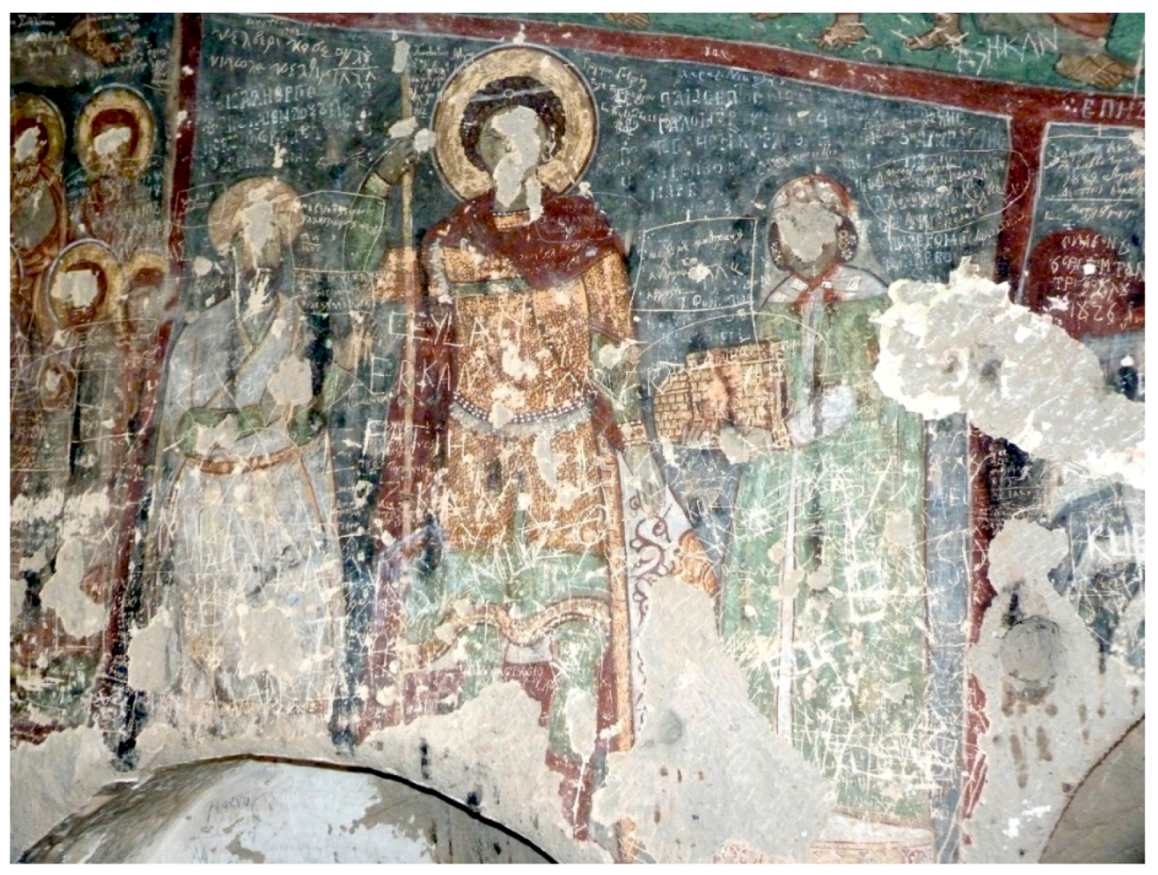


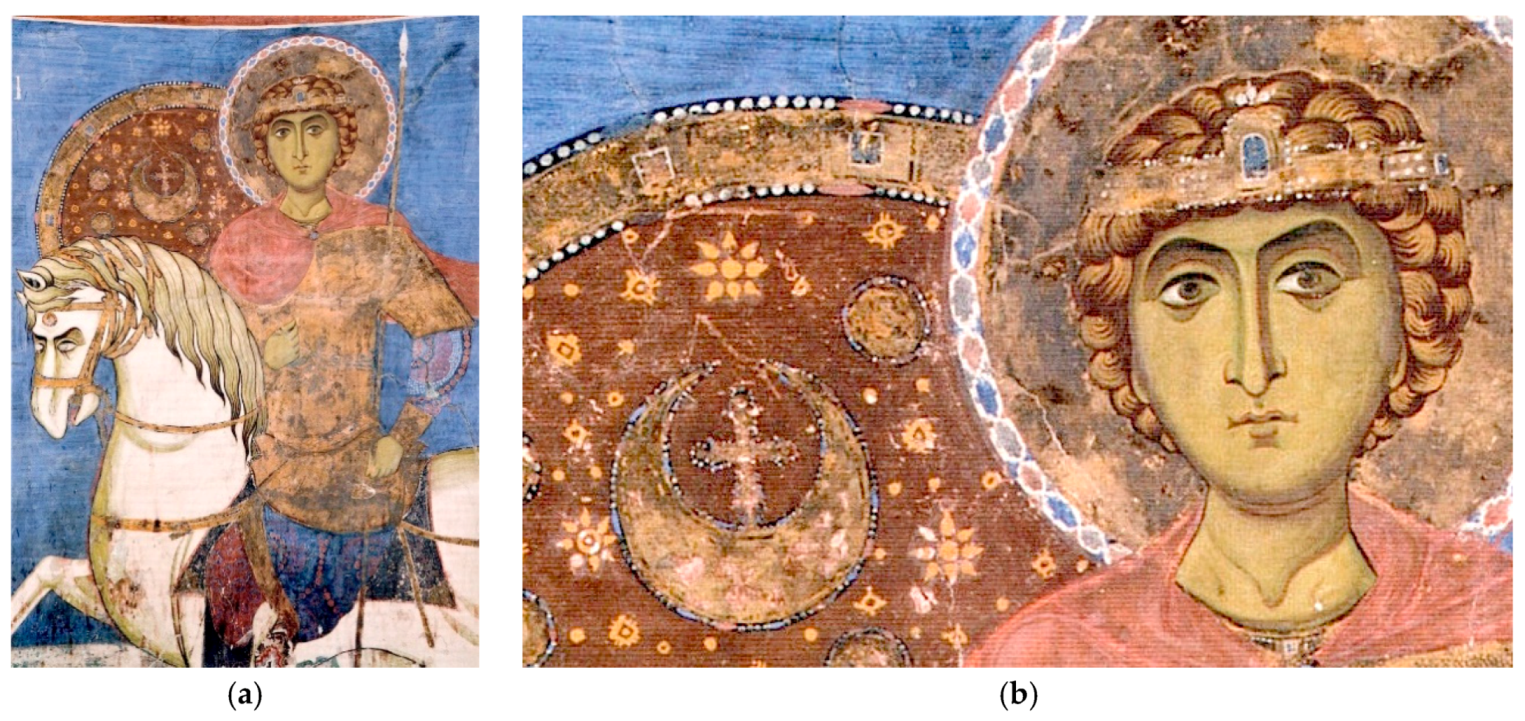


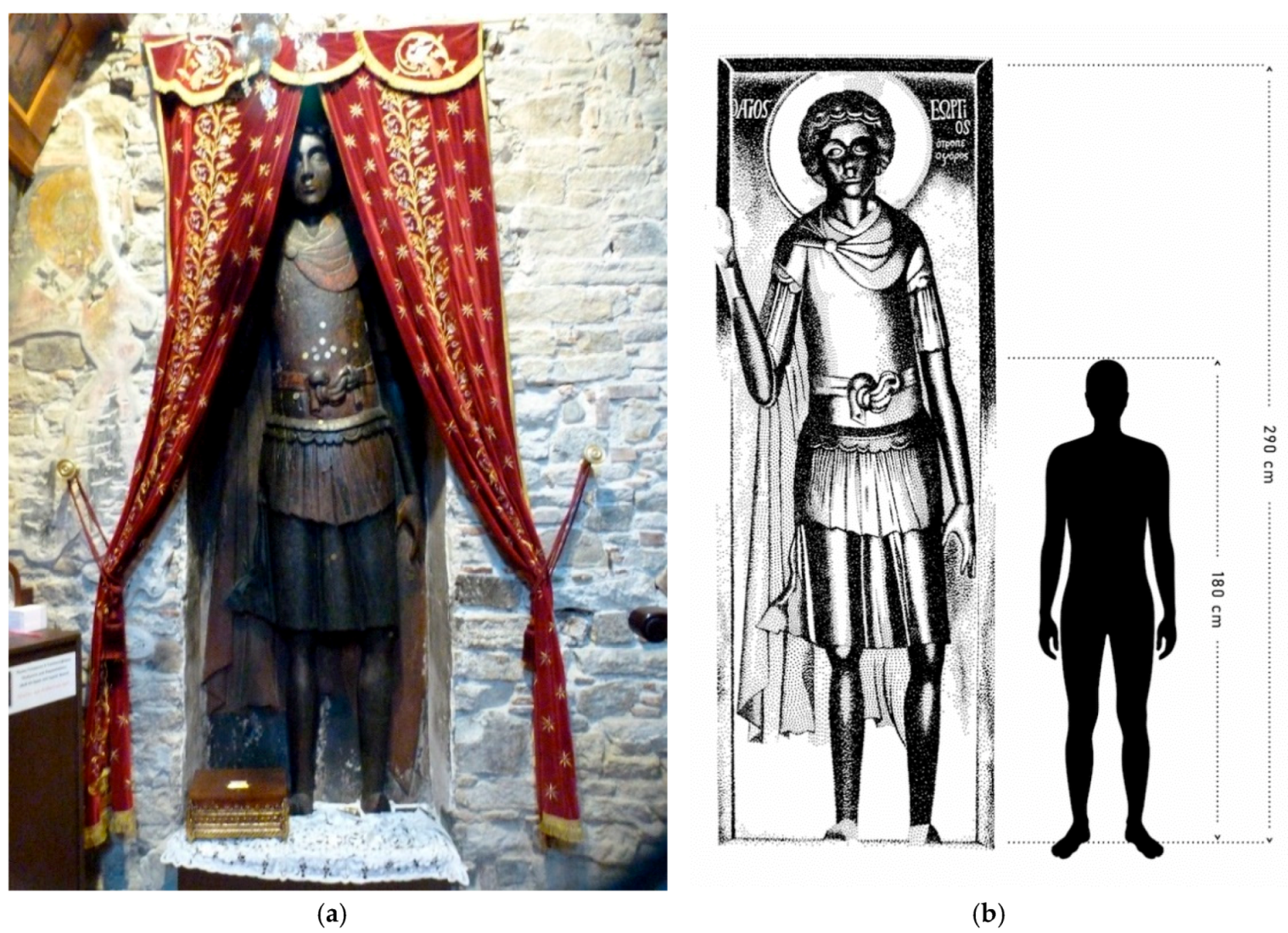
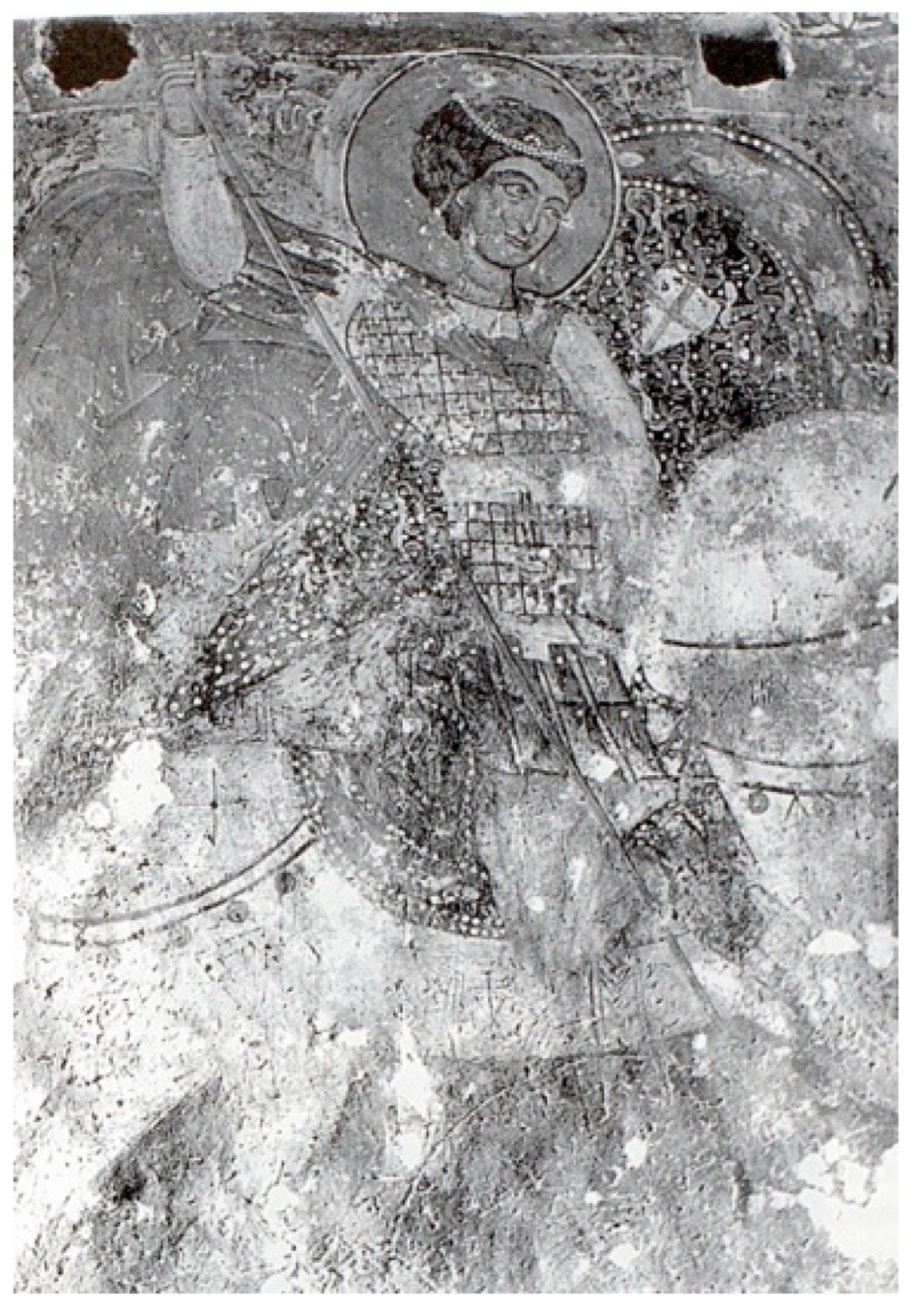
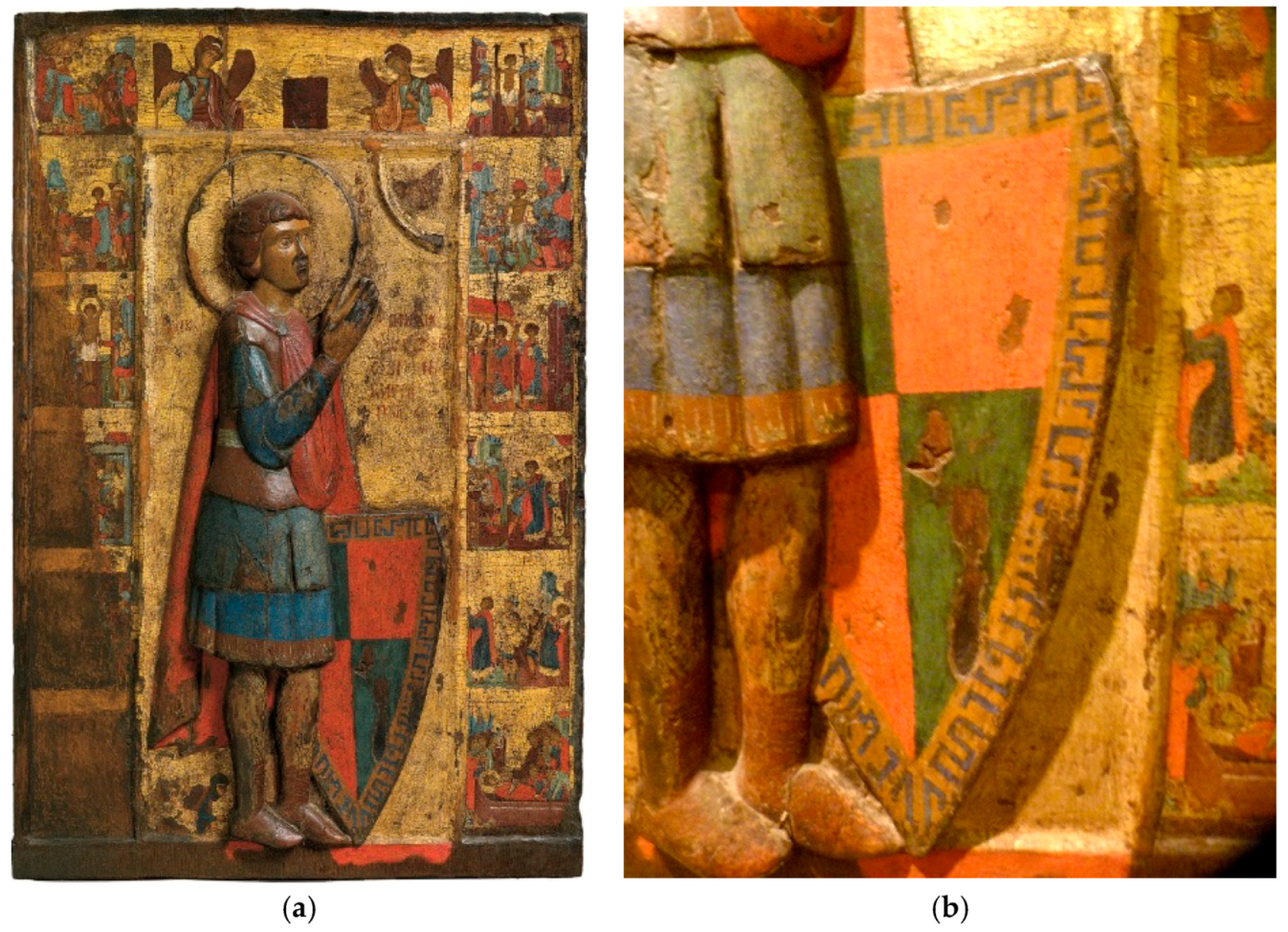
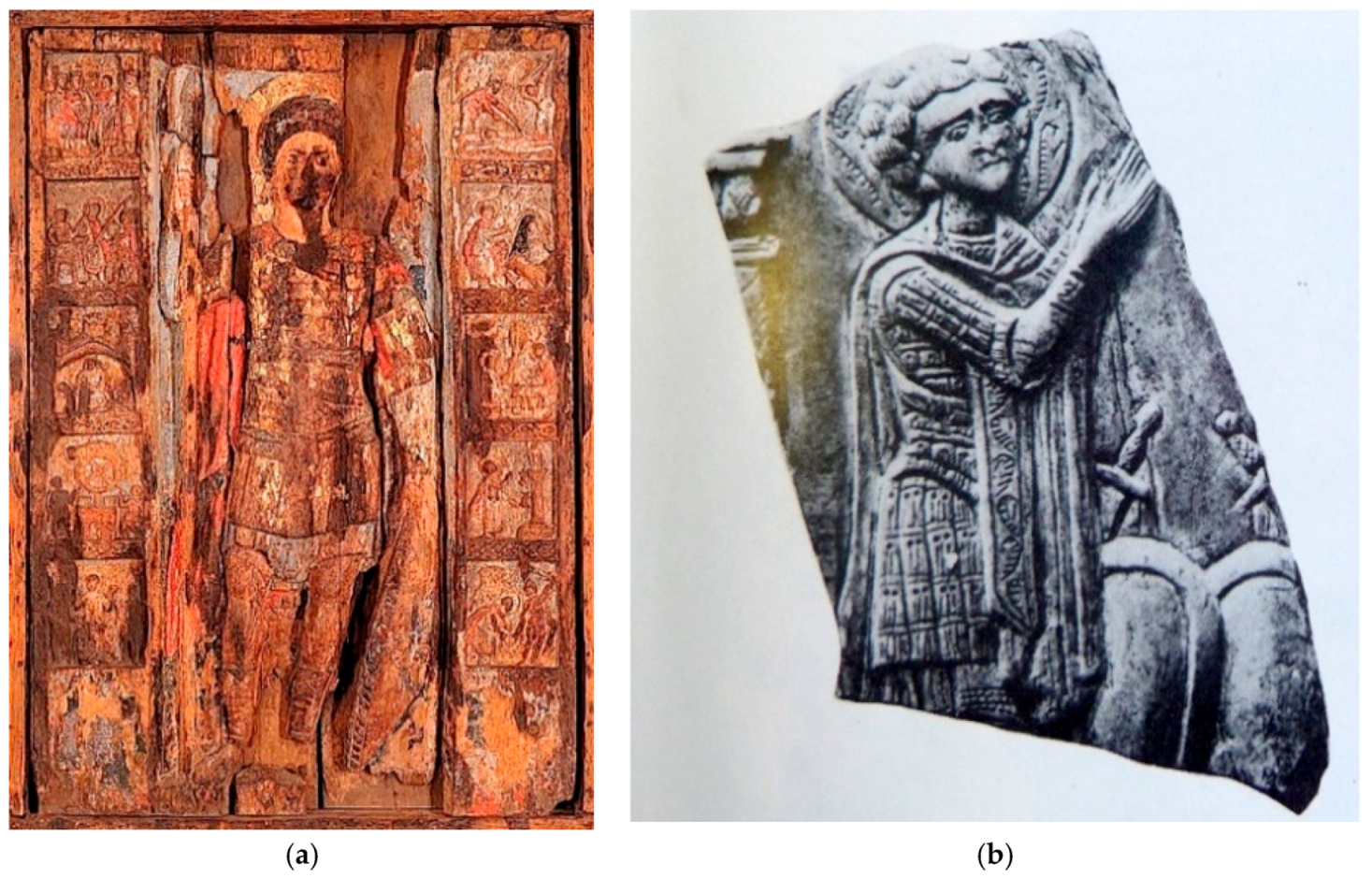



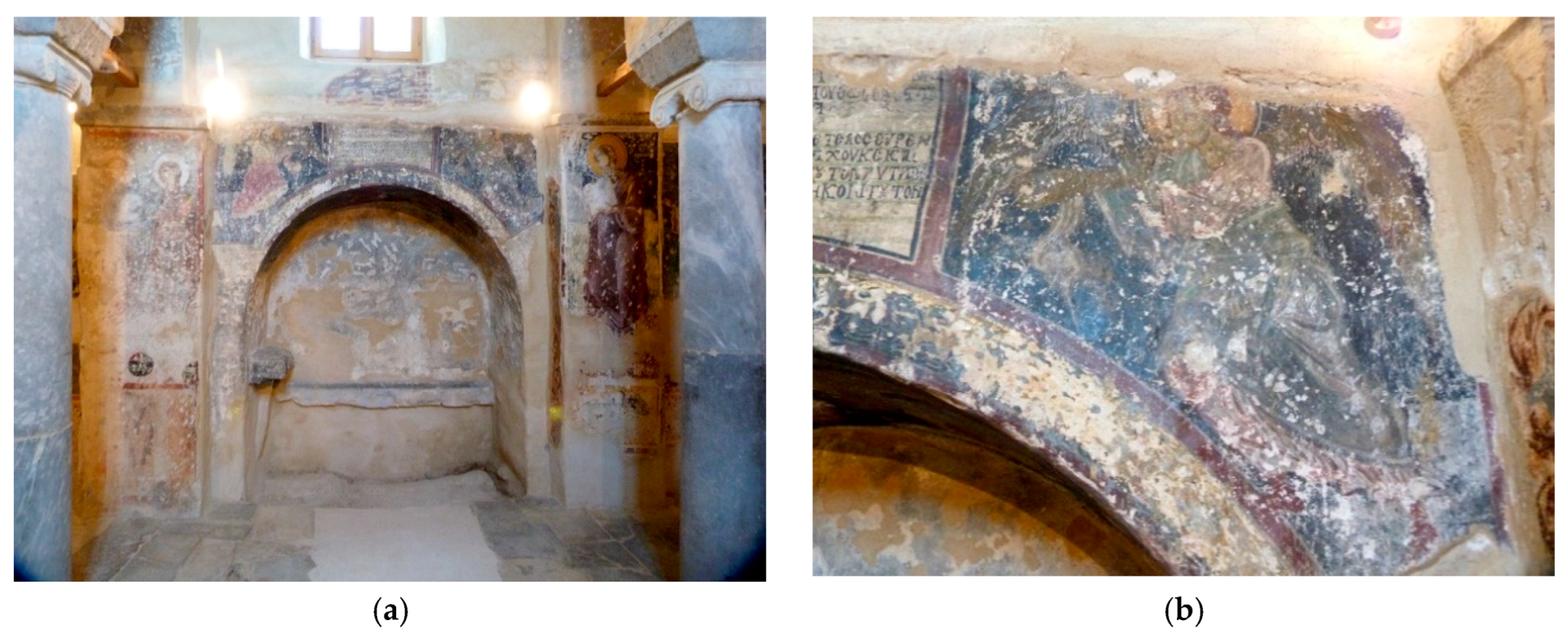





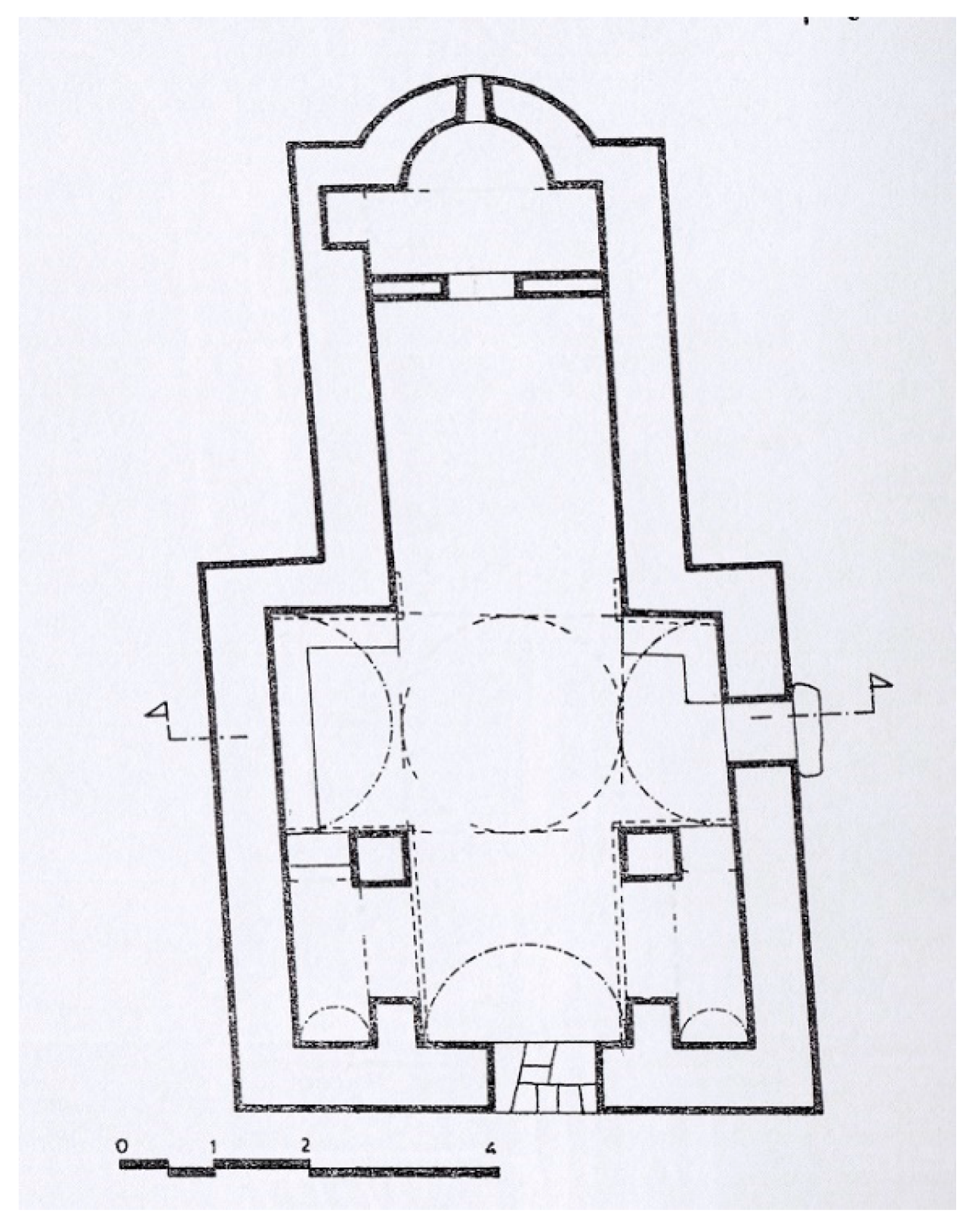
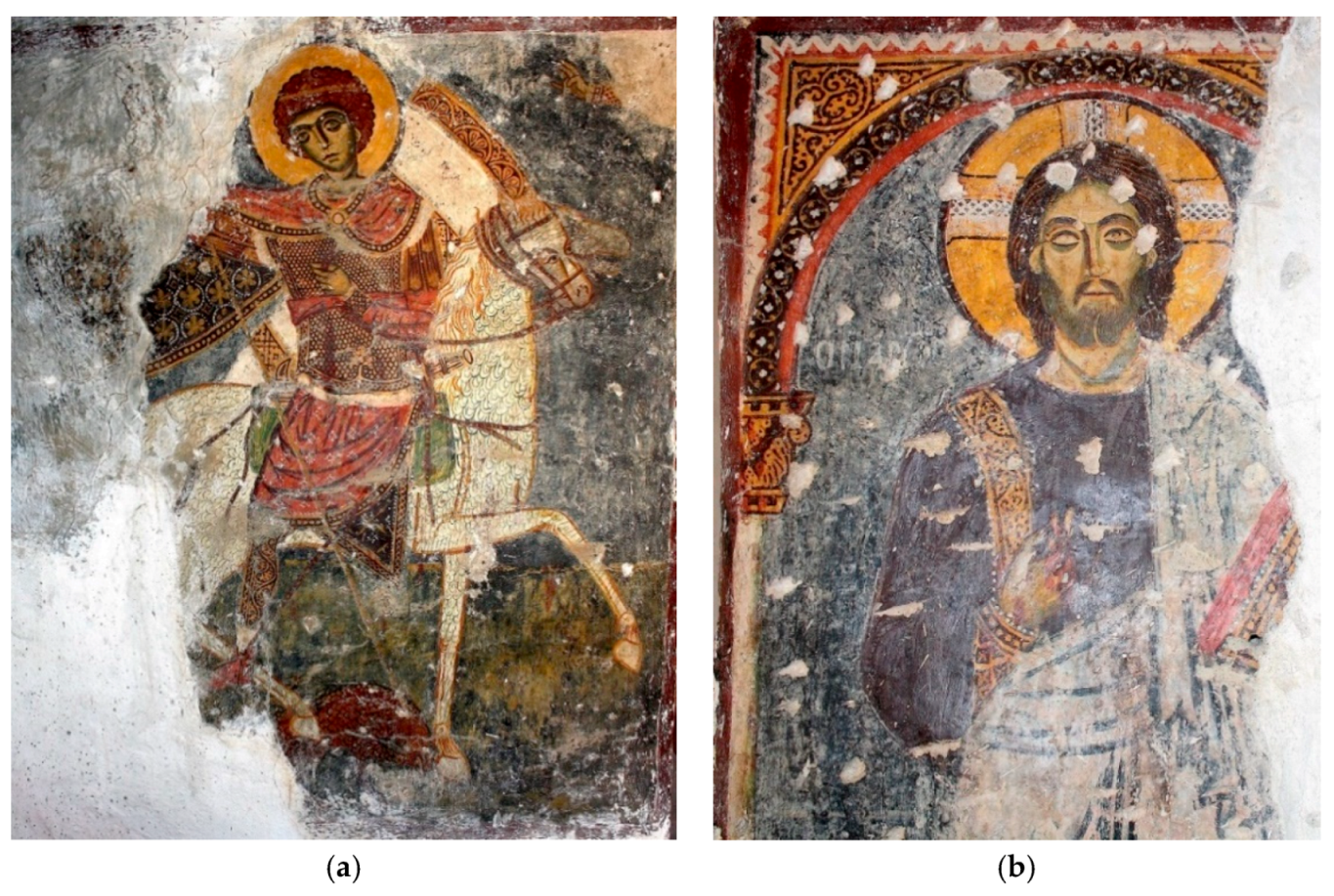
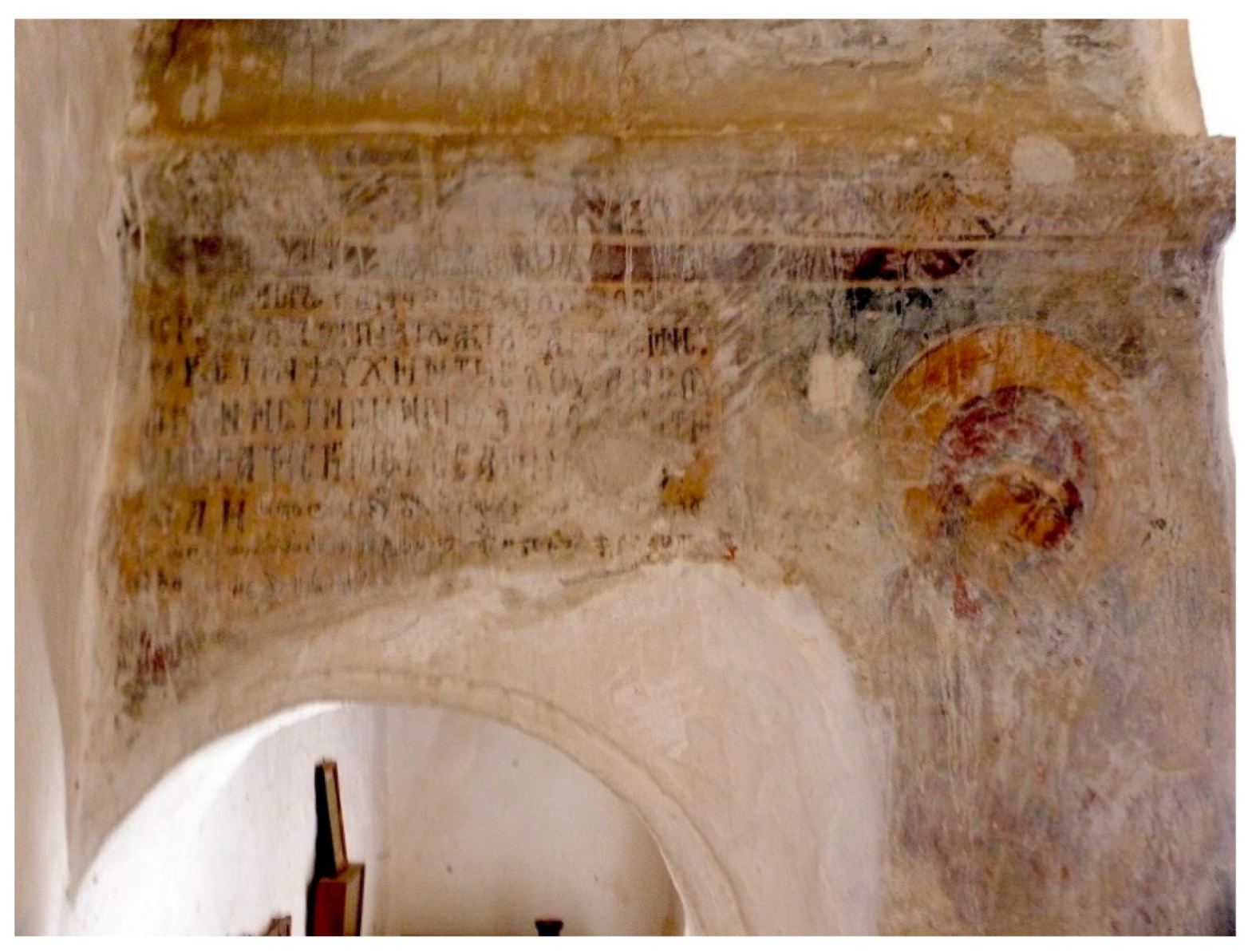
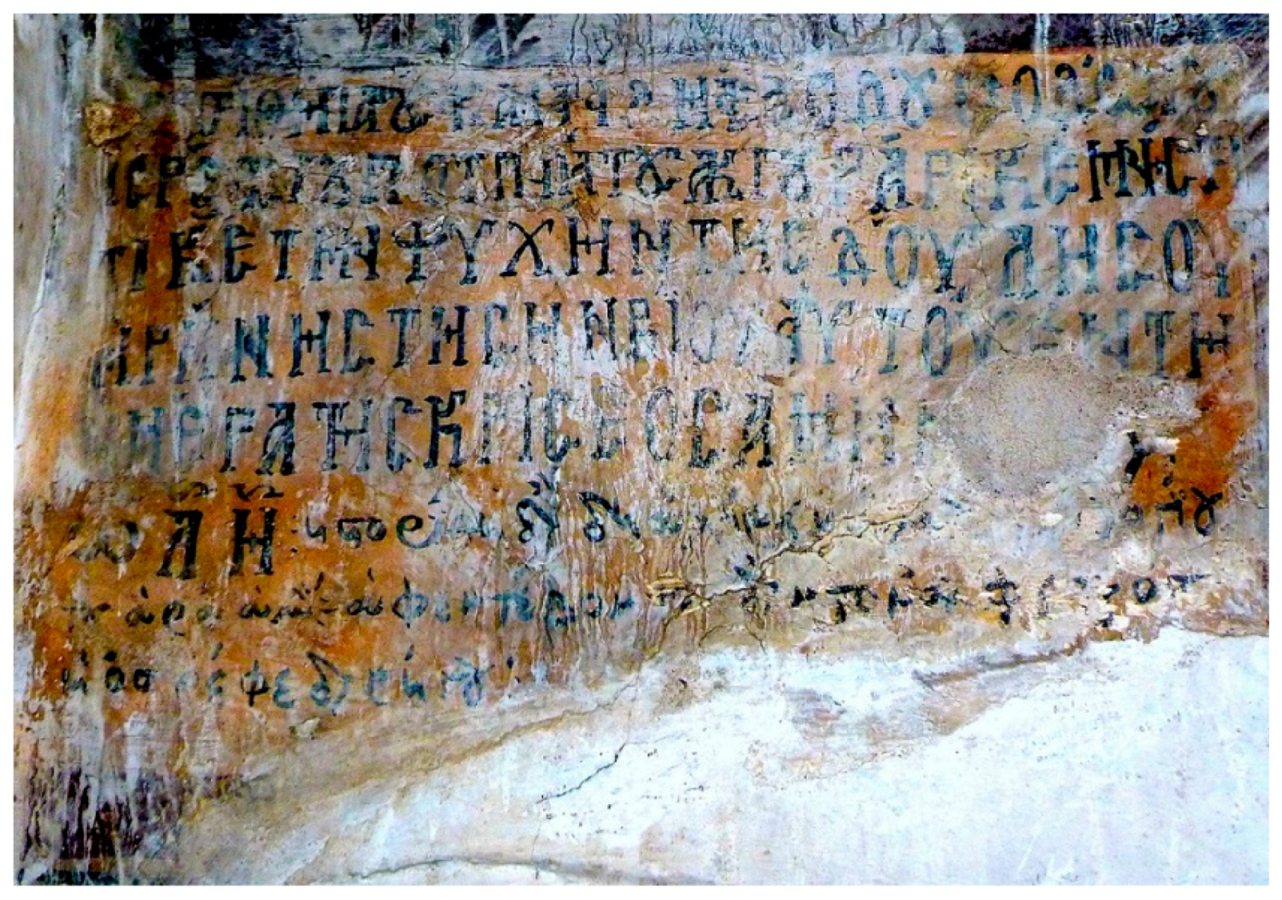


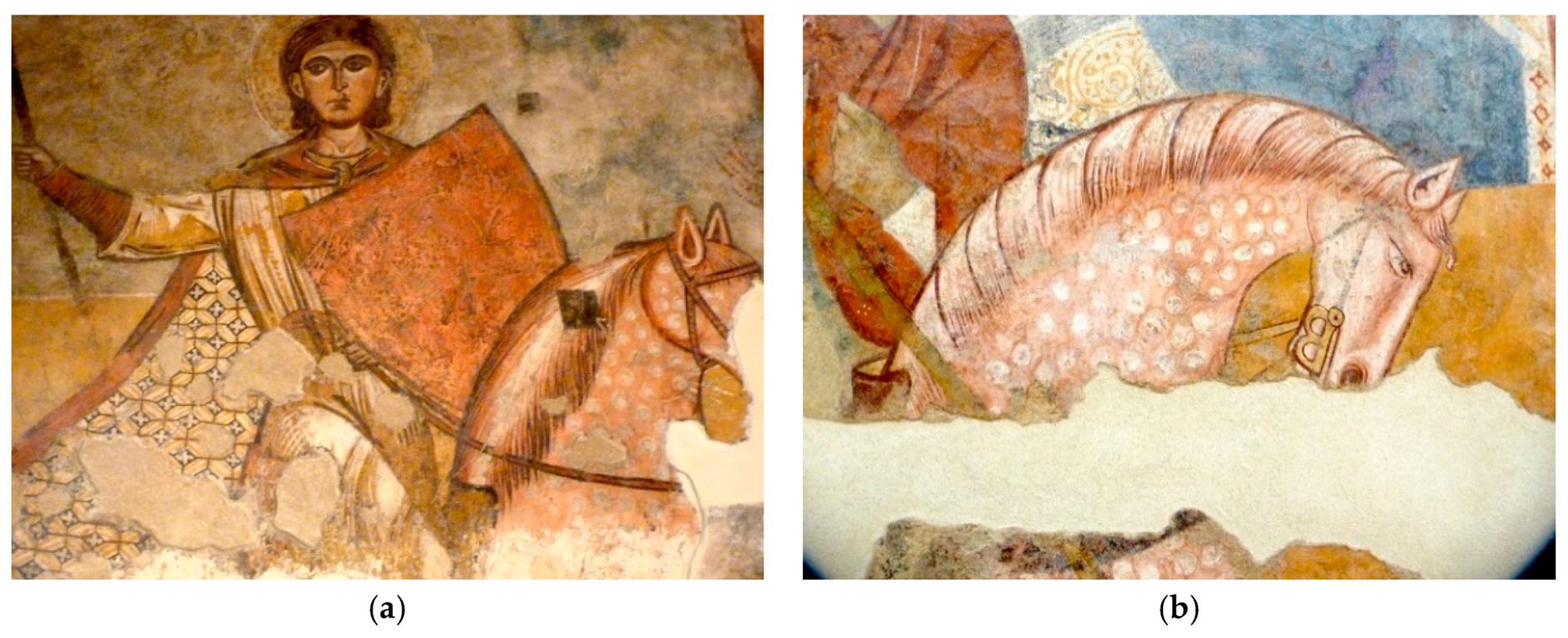
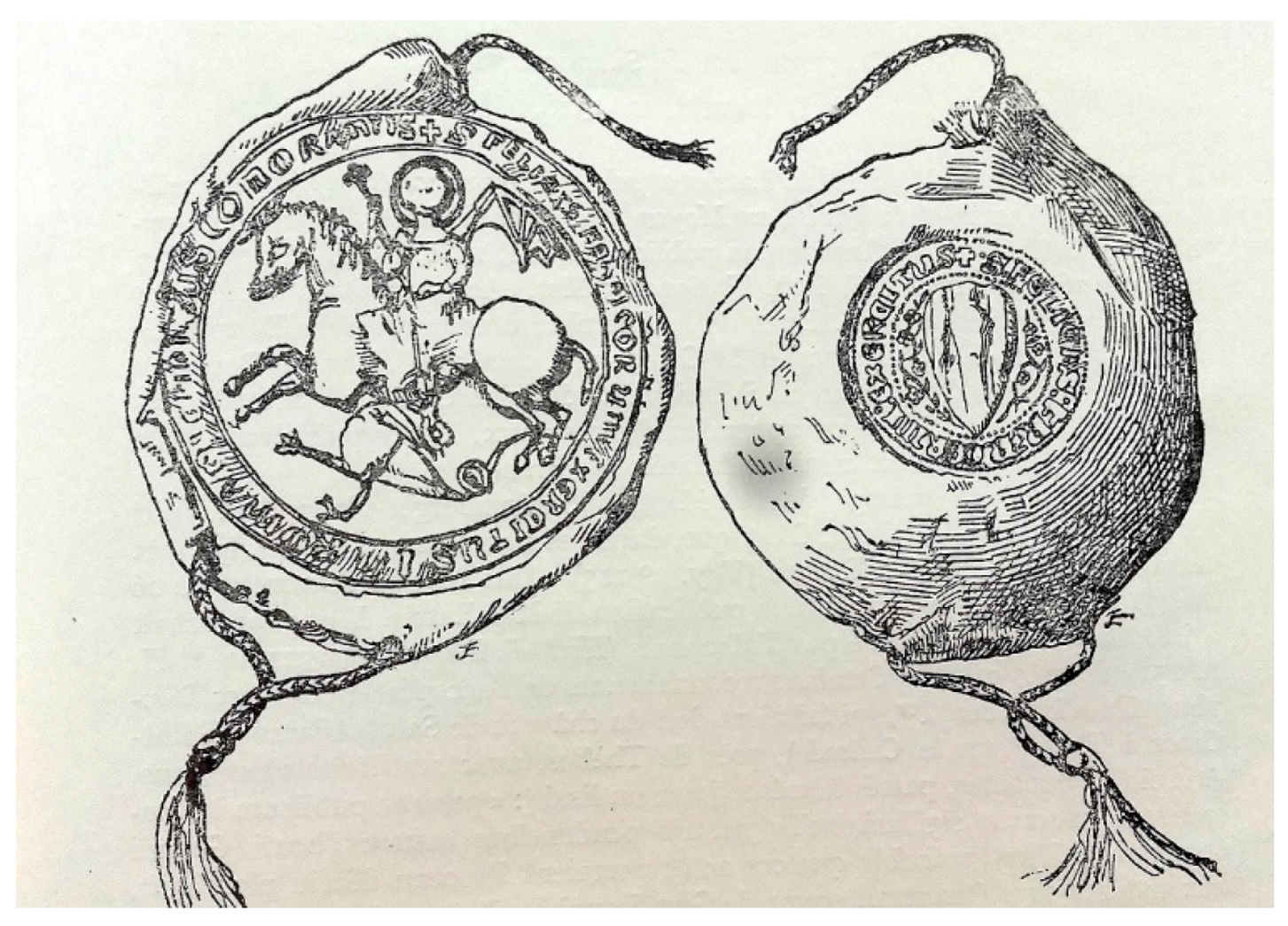
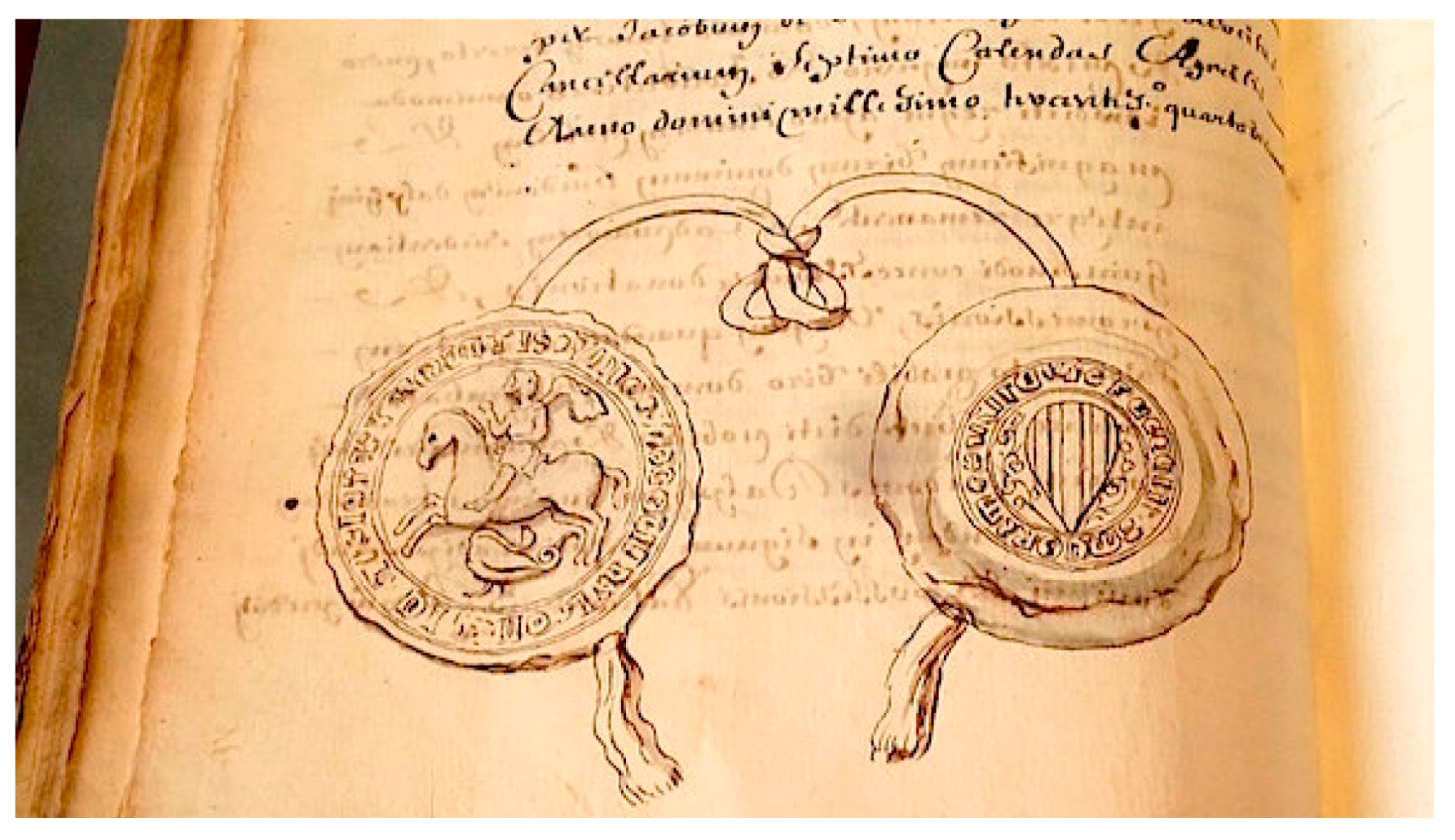
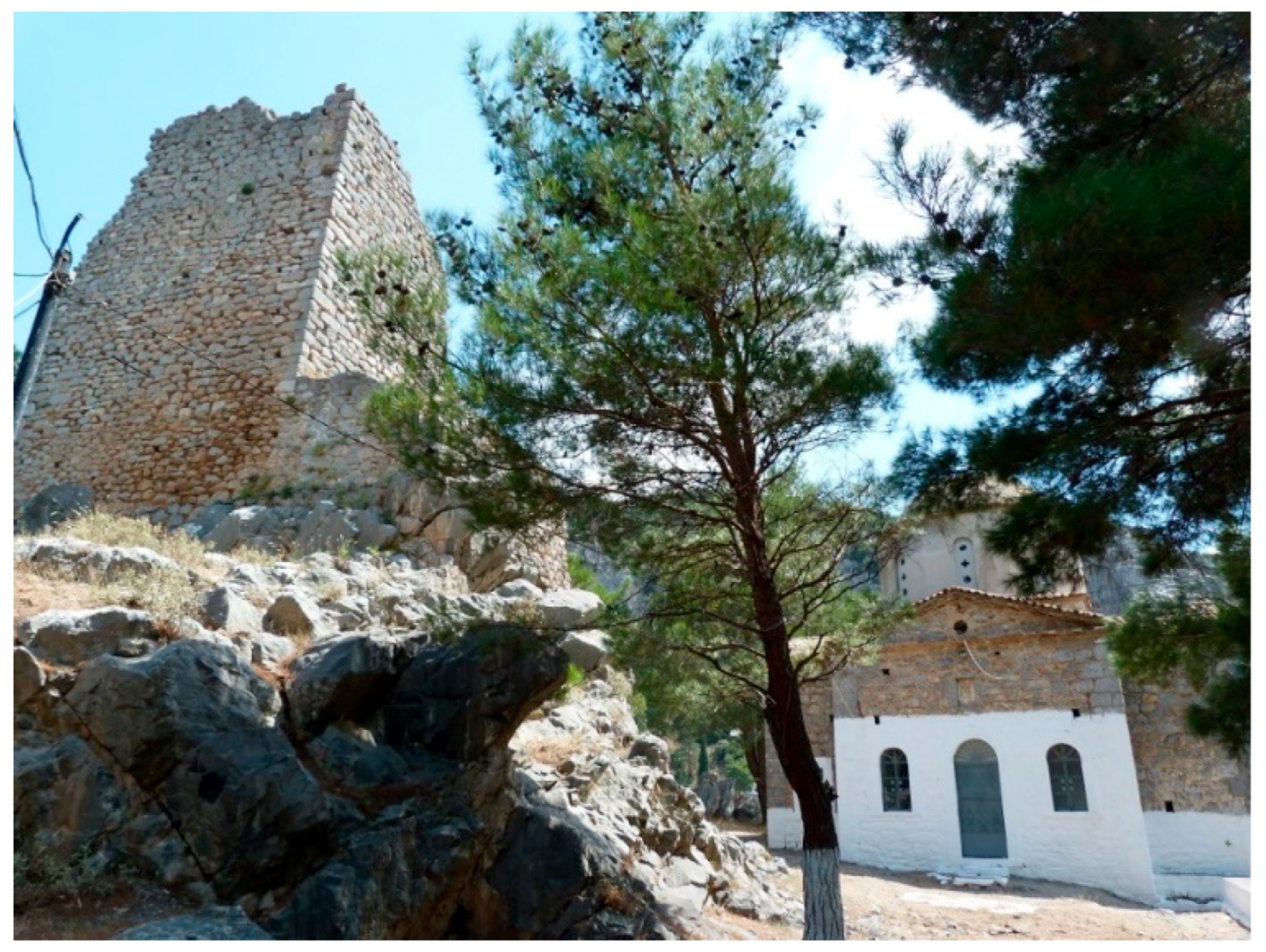

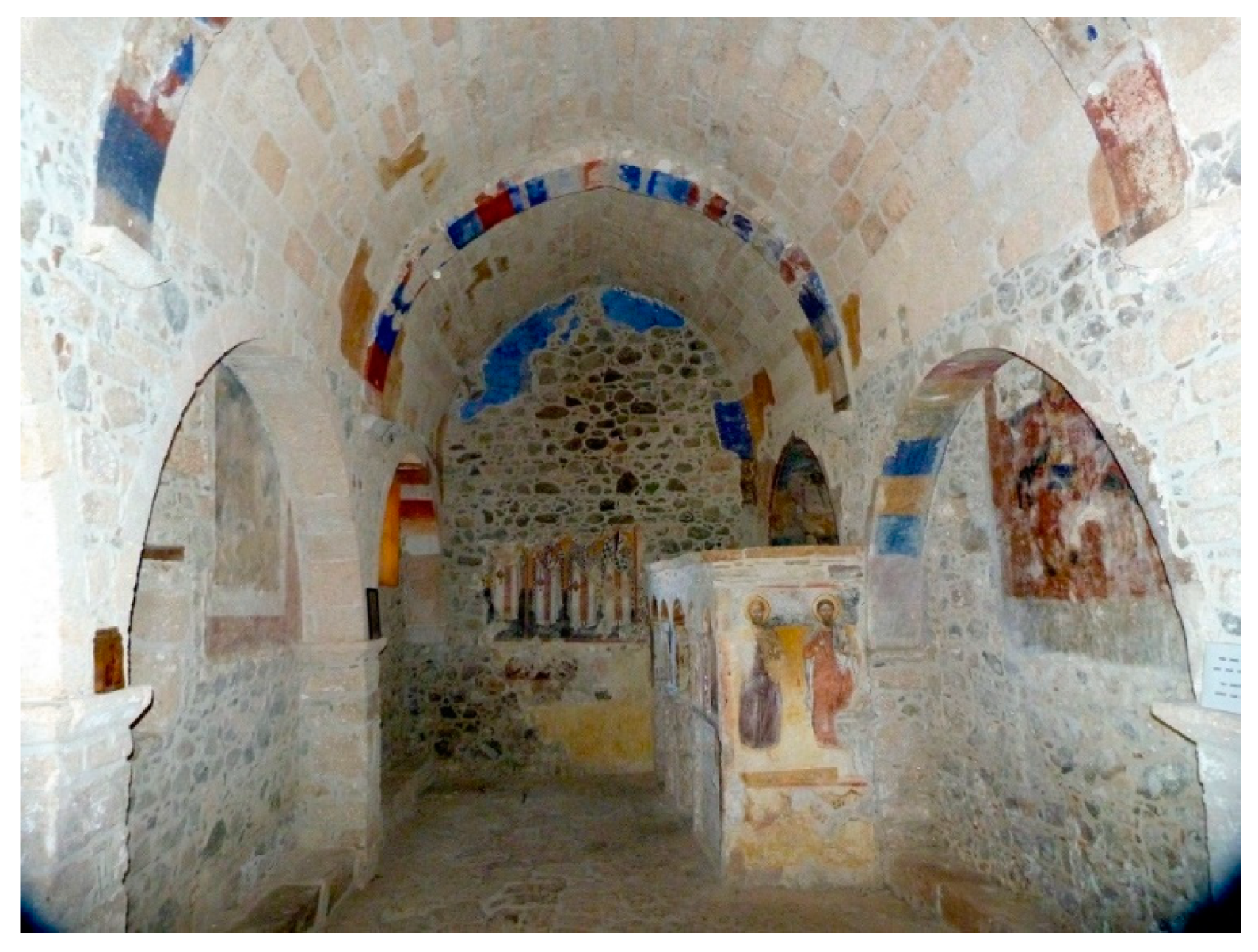

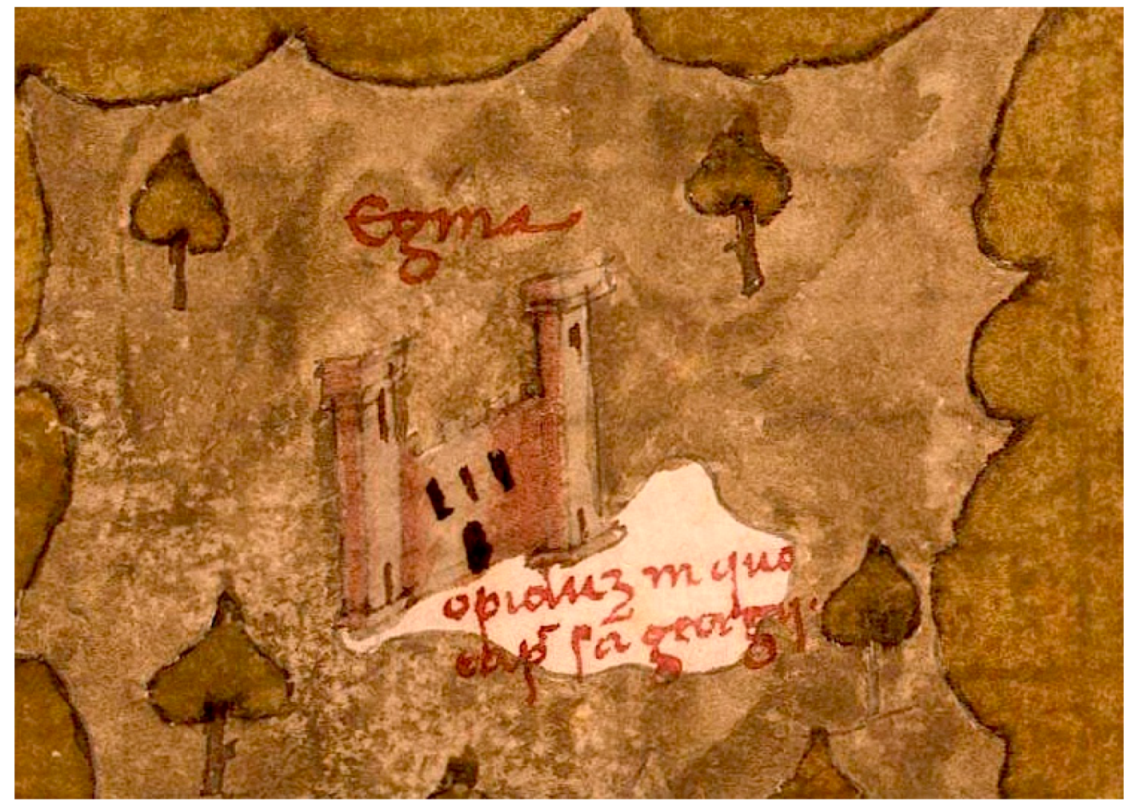


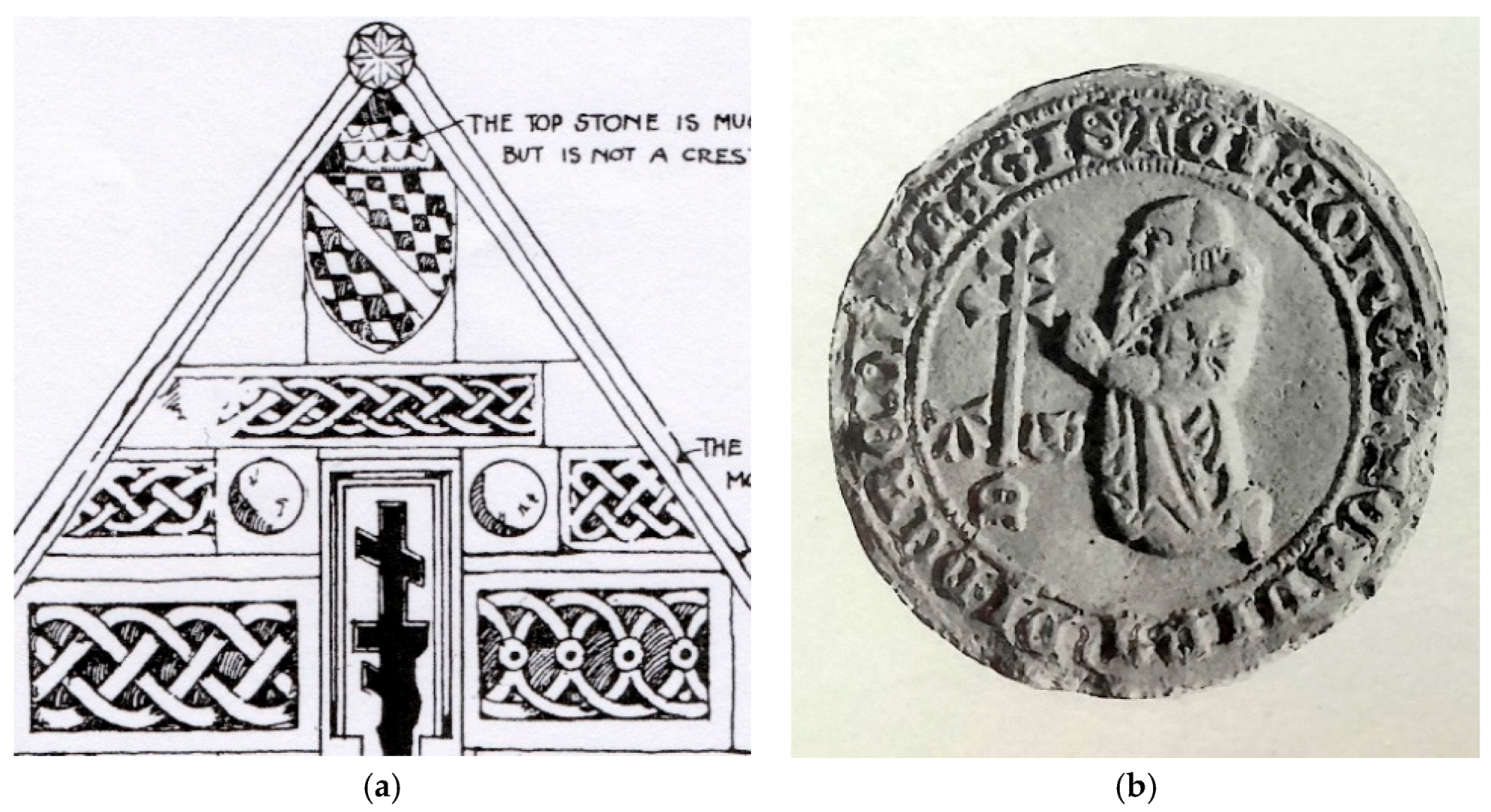
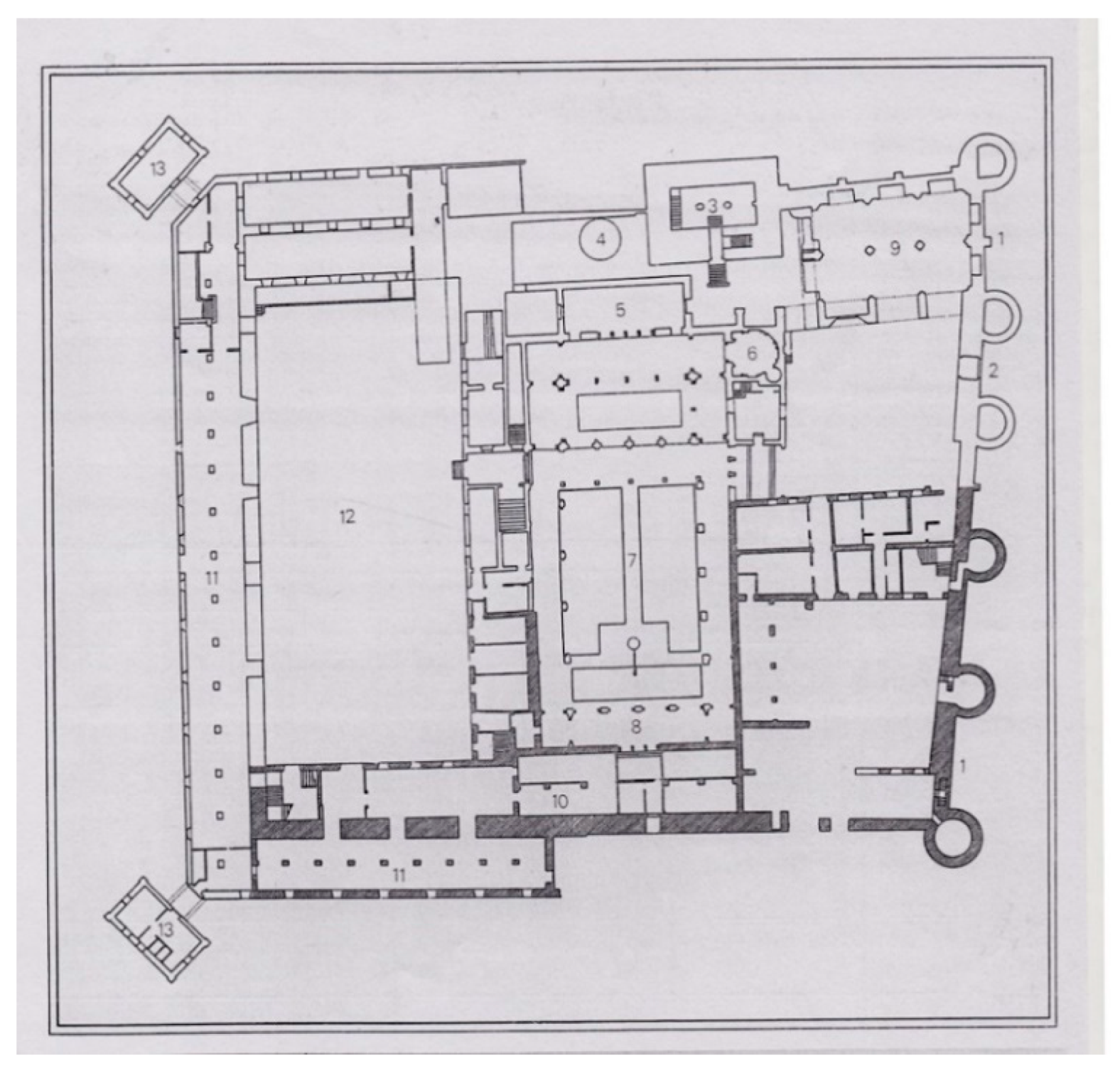
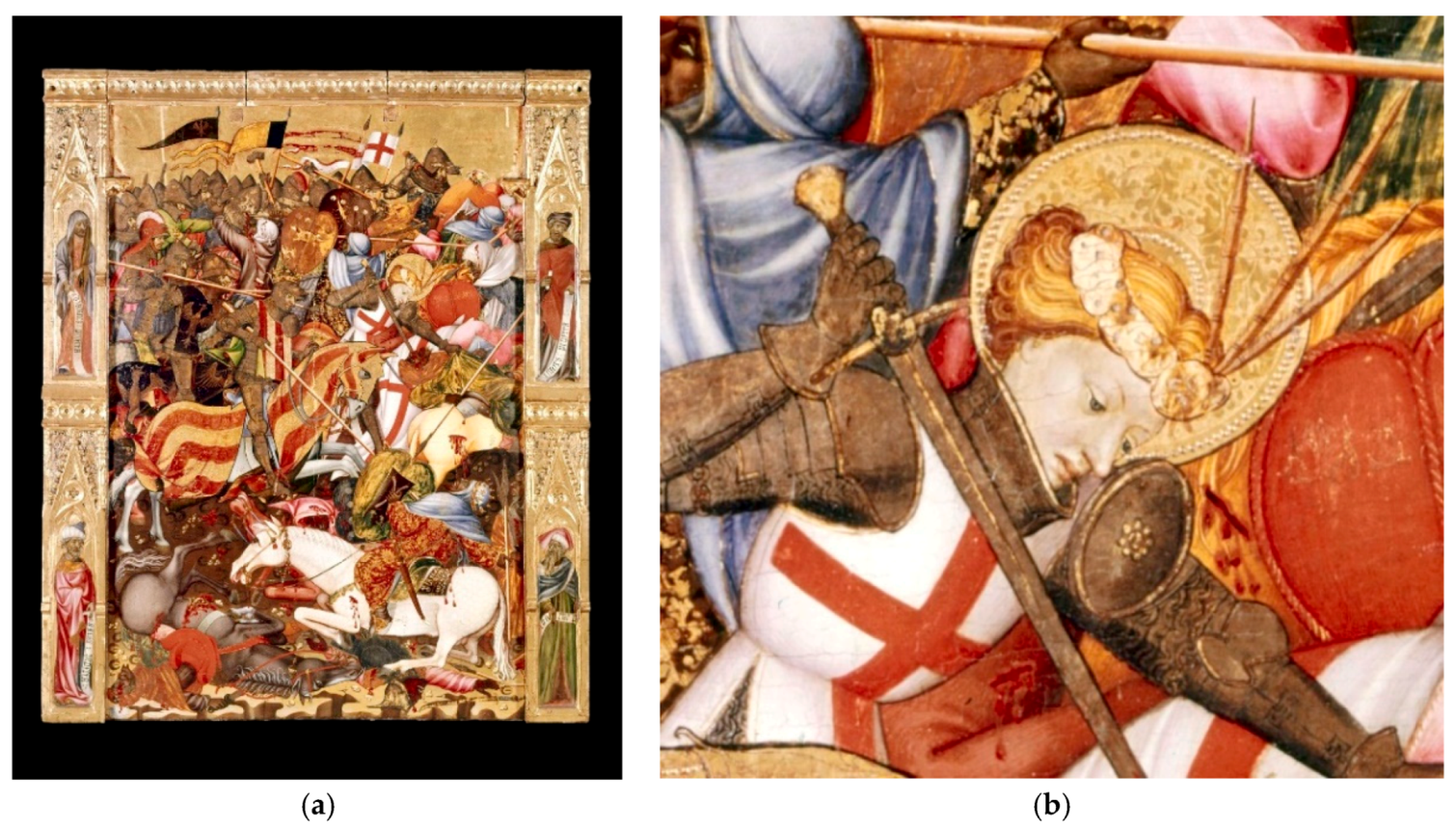
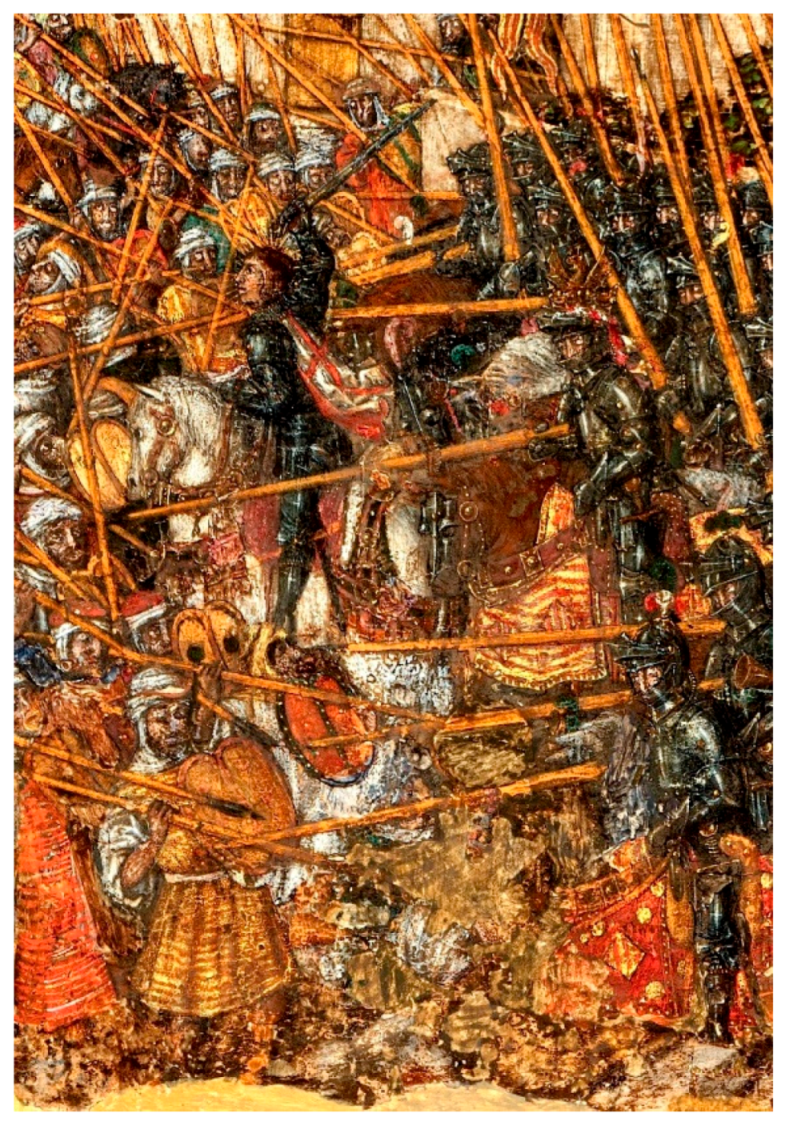

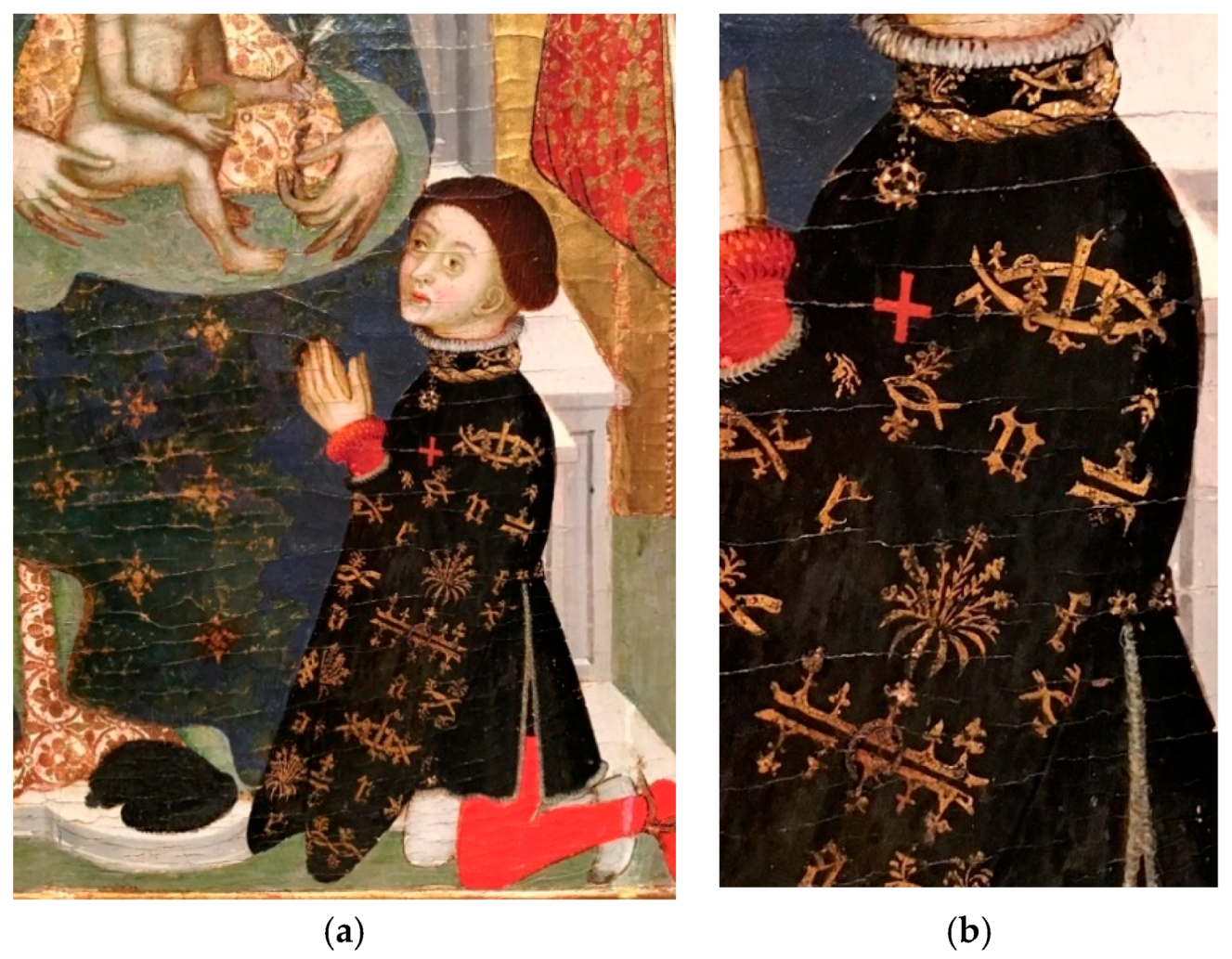
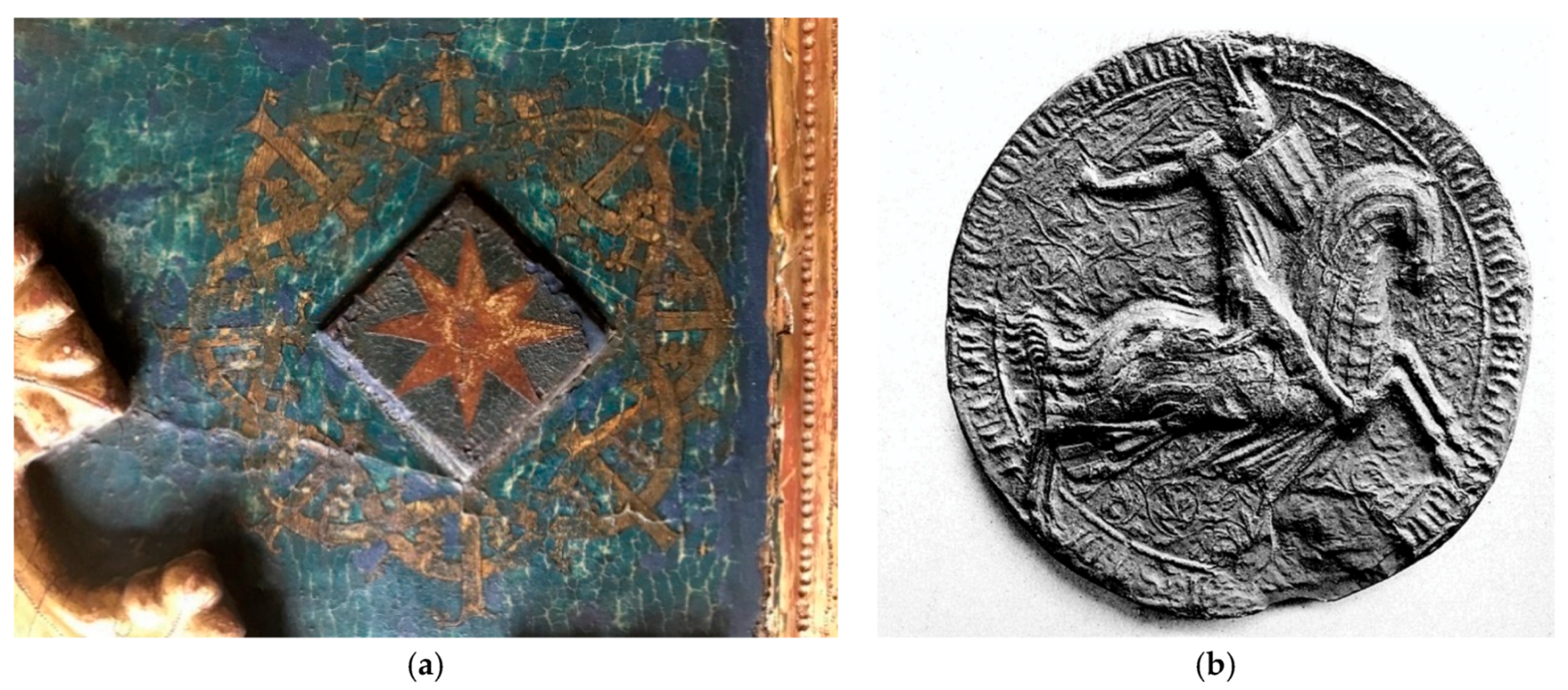
© 2020 by the author. Licensee MDPI, Basel, Switzerland. This article is an open access article distributed under the terms and conditions of the Creative Commons Attribution (CC BY) license (http://creativecommons.org/licenses/by/4.0/).
Share and Cite
Castiñeiras, M. Crossing Cultural Boundaries: Saint George in the Eastern Mediterranean under the Latinokratia (13th–14th Centuries) and His Mythification in the Crown of Aragon. Arts 2020, 9, 95. https://0-doi-org.brum.beds.ac.uk/10.3390/arts9030095
Castiñeiras M. Crossing Cultural Boundaries: Saint George in the Eastern Mediterranean under the Latinokratia (13th–14th Centuries) and His Mythification in the Crown of Aragon. Arts. 2020; 9(3):95. https://0-doi-org.brum.beds.ac.uk/10.3390/arts9030095
Chicago/Turabian StyleCastiñeiras, Manuel. 2020. "Crossing Cultural Boundaries: Saint George in the Eastern Mediterranean under the Latinokratia (13th–14th Centuries) and His Mythification in the Crown of Aragon" Arts 9, no. 3: 95. https://0-doi-org.brum.beds.ac.uk/10.3390/arts9030095




